
- Subscribe Now
- Digital Editions


Best hydrofoil boats: 6 of the most spectacular foiling motorboats money can buy
- Electric boats
- Top stories
Foiling technology has really taken off in the past few years. We pick out 6 of the best hydrofoil boats you can buy right now…
With its roots in the 19th century, foiling technology is as old as the hills, but in the past five years we’ve noticed an explosion of hydrofoil boats coming onto the market.
In part inspired by the foiling raceboats of the America’s Cup , the popularity of foiling is easy to understand – fuel efficiency gains are substantial, noise is almost eliminated (particularly if your foiling boat also happens to be an electric boat ) and they look as cool as a snowman in a freezer!
To help you understand the dizzying array of foiling boats available right now, we’ve put together the following guide to what we think are the most promising designs out there.
6 of the best hydrofoil boats

SEAir foiling RIB
Founded in 2016, French yard SEAir builds foiling RIBs, having been inspired by the speed of foiling racing yachts.
We tested their 5.5m model back in 2018 and since then they have expanded their range to cover superyacht chase boats, commercial and military vessels.
Our tester recorded a top speed of 32 knots, with the foils doing their best work at around 20 knots, but SEAir claims that 42 knots is possible in the right conditions.
Read more about the SEAir foiling RIB
Article continues below…

Spirit Yachts launches spectacular long-range electric flying boat
BMW launches new ICON electric boat at Cannes Film Festival
The Cannes Film Festival has seen the launch of the new ICON electric boat. Created by BMW in collaboration with

A dual helm set-up allows the boat to be piloted from the bow or the cockpit. Photo: Guillaume Plisson
Enata Foiler
Dubai-based Enata Marine added a healthy dose of glamour to the world of foiling boats in 2018 with the launch of its Foiler.
In addition to a superyacht tender-worthy exterior, this 32fter includes a bow window for spectacular views while underway.
A 40-knot top speed and a 190nm range makes this a very appealing option, although the premium price tag of $938,000 may put some off.
Read more about the Enata Foiler

Princess R35
When British boatbuilding giant Princess Yachts got in on the foiling boat game in 2019 with a 35ft carbon-fibre dayboat, we knew that things had really taken off.
While the foil-assisted R35 may not have the spectacular cruising-above-the-waves appeal of some other foiling boats, it is highly efficient, beautifully designed (in collaboration with Pininfarina) and handles like nothing else we’ve ever driven.
In our review, we praised its rare combination of agility, refinement and stability, with spray kept in check impressively at high speeds.
Read more about the Princess R35

The foiling Candela C-8 is the first boat to use Candela’s proprietary C-POD, but bigger craft will follow later
Candela C-8
Swedish firm Candela burst onto the scene in 2021 with its debut, the Candela C-7 , which was billed as the world’s first electric foiling boat, but it was the 2022 launch of the Candela C-8 that really moved the game on.
Available with a 69kWh battery, adapted from the Polestar 2 electric car, owners can expect a range of 57nm at 22 knots, more than enough for dayboat use.
The consumption figures are truly staggering, with Candela’s figures suggesting that the C-8 is more than 12x more efficient than an equivalent 300hp outboard powered sportsboat.
Read more about the Candela C-8

The electric Iguana is capable of three knots on the land and 30 knots at sea
Iguana Foiler
Not content with being at the forefront of the amphibious boats market with its caterpillar-track offering, French yard Iguana has set its sights on the world of foiling too.
Announced last year, the Iguana Foiler will be powered by the world’s most powerful electric outboard engine, the 300hp Evoy Storm .
Having tested both the engine and the boat separately, we can’t wait to see the result when they come together with the added advantages of foiling technology. Watch this space…
Read more about the Iguana Foiler

The foils lift up at slow speeds to reduce the draft
Mantaray M24
Another exciting model in the hydrofoil boats pipeline, this 24ft runabout is particularly interesting is its simplicity. Unlike its main foiling rival, the Candela C-7, the Mantaray M24 requires no complicated electronics to ‘fly’.
Instead it uses the builder’s patented mechanical hydrofoil system, which it has trademarked as Dynamic Wing Technology or DWT. The technology is said to be the result of ten years’ development work and uses a retractable T-foil in the bow and H-foil amidships that self-stabilise mechanically.
This allows it to lean naturally into corners and ride serenely over waves without relying on a network of sensors and algorithms to monitor and adjust the foils. If it proves effective this could drastically reduce the cost and complexity of foiling boats, while simultaneously increasing reliability.
Read more about the Mantaray M24
It doesn’t end here, with fascinating one-off projects from Spirit Yachts and BMW on the water, it’s clear that foiling has a huge potential for transforming the world of boating.
Read more about hydrofoil technology
New boats at Southampton Boat Show: Saxdor 400 GTC
New boats at the southampton boat show: sargo 45, new boats at southampton boat show: cormate chase 35, latest videos, watch: parker sorrento sea trial: 50-knot cruiser with a killer aft cabin, watch: virtue v10 sea trial: €272k weekender, how to mark your anchor chain: 6 top tips from our expert, watch: galeon 560 fly sea trial – the best galeon flybridge you can buy.

12 foiling boats for sailors of all levels
- April 15, 2022
- No Comments
THE PERFECT GIFT!
Give or treat yourself to a subscription to the print + digital Journal of Sailing and for only 69 euros a year you get the magazine at home plus read it on your PC, smartphone and tablet. With a sea of advantages.

There’s no denying that the phenomenon of the moment, when it comes to having fun, is foiling boats (as Checco Bruni told us himself in this article). In the wake of the latest editions of the America’s Cup, flying boats, especially in the dinghy segment, have become increasingly widespread. On one or two hulls, with one or more foils, more or less easy to fly, single or crewed.

We have selected for you 12 flying boats with which to enter the world of foils or with which to try and perfect your skills. We also tell you how much they cost and the “difficulty of flight” (XXX: difficult; XX: medium; X: easy). The only common denominator is that they are great fun!
Birdyfish – 4,7 m – For foiling beginners
Flying difficulty: X

The ideal boat for learning to sail foils, even for beginners. Very few trim adjustments for foils allow you to enjoy all the excitement and joy of flying. The crew will only have to deal with sail trimming. The appendages with a soft-angled L guarantee take-off from 10 knots of wind. The shape of the bow works well even in waves. Price: 16,980 euros.
FIND OUT MORE
Flo1 – 4.25 m
Flying difficulty: X

An interesting single to approach and perfect in the world of small foilers before moving on to more sophisticated craft. Produced by the Dutch company Aeronamics, it has a soft, almost C-shaped foil. There is no adjustment of the rake of the appendages but only its extension in the water, which makes the “trim” of these appendages easy and intuitive after just a few trips. Top speeds are around 20 knots. Price: 15,495 euros.
DISCOVER MORE
NACRA F20 – 6,20 m – Like America’s Cup cats
Flying difficulty: XXX

The Nacra yard, which specializes in open catamarans and produces the Nacra 17 Olympic class, has fitted its F 20 model with a “Flight Control System” to make it fly. The Nacra 20 FCS was designed by Pete Melvin and Gino Morelli, the authors of the 2013 America’s Cup rulebook, and its foils are reminiscent of those on the AC72 in San Francisco. A very physical boat and not for everyone. Price: 34,000 euro.
Foiling Dinghy – 3,86 m – Small and versatile

It weighs 30 kilos and can be foiled as early as seven knots of wind. The Foiling Dinghy is equipped with an inverted T rudder and a pair of curved foils that act as both lifting and straightening foils, with an automatic management system. The foils have a few simple adjustments depending on what you want to achieve (more flying or more straightening). Price: 15,500 euros including taxes.
Moth – 3,35 m – The foiling cult dinghy

The progenitor of the flying dinghies is still one of the most complete single foilers on the market today. Suitable mainly for advanced sailors who already have experience on foils, it has appendages that offer multiple setting options and the possibility of being changed according to wind strength. The international class is one of the most active and always organizes very crowded races. Cult product. Price: from 20,000 euros.
Peacoq 14 – 4.70 m – Like a flying Fireball
Flying difficulty: XX

With a hull that is vaguely reminiscent of the old Fireballs with a “cut” bow, the Peacoq 14, an evolution of the Club version, is a dinghy that can be a compromise for both novice and experienced foil sailors. In fact, the dinghies can be operated in automatic trim, or more experienced sailors can adjust their angle for maximum performance. Price: quote on request.
Persico 69F – 6,9 m – The trendy boat

This concept boat is the brainchild of the Italian racing elite (Giorgio Benussi, Dede de Luca, “l’oriundo” Maciel Cicchetti) and was designed by Argentineans Wilson and Marquinez. Flying the 69F is not too difficult, although it does require a good physique and strength in the arms, especially for the mainsail trimmer and the foil adjuster. The racing circuit has now been launched with an attractive programme. Price: rented by the season.
Skeeta – 3,35 m – Easy for anyone

Ease first. The idea behind Skeeta is the same as that of many other small foilers: to make this type of wing easy and open to everyone. Skeeta is a single glider that flies on two self-regulating appendages, not particularly technical to fly but still very high performance, with the particular shape of the hull that distinguishes all Quant models. Price: 15,345 euros.
Stunt S9 – 4,16 m – The Italian Foiling cat

This is an all-Italian One Design catamaran that can be sailed as a single with just a mainsail or even a jib depending on the weather conditions. Like other catamarans, to improve stability in flight, it moves on four submerged appendages. Physically it requires a certain amount of athleticism, also because there is a trapeze, but with a little training it can be suitable for a wide audience. Price: 16,600 euros.
Ufo – 3,00 m – Flying with two hulls

This small catamaran is equipped with a sensor that self-adjusts the inclination of the single central foil, coupled to the T of the rudder. It can take off even in light winds thanks to the lightness of its construction. The cat is quite easy to sail, suitable even for sailors who do not have much experience with foils.
The official european dealer for Foiling UFO is Sea-Change . Price: 8.980 euros + VAT
Waszp – 3,35 m – For the whole family

Very similar to the Moth, but with one big difference: the Waszp is a monotype, it is not made of carbon and the appendages being monotyped cannot be changed. For this reason it is less expensive than the Moth, even if it does perform somewhat less well. It is considered by many to be an ideal “family” boat because it is fun for both young and old. The foil adjustment system is managed by a sensor, but it is possible to set the appendages and modify some adjustments. Price: 12,200 euros.
Whisper – 5,40 m – Full performance

As light as the highest performing Cats, it features a one-piece, non-removable platform that provides great structural rigidity. Equipped with the four classic self-adjusting appendages, it is able to set sail in light breezes with a certain ease. It is a double, with trapeze, mainsail, jib and gennaker, fast even in light winds. Physically demanding. Price: 26,900 euros.
HELP US TO KEEP YOU ALWAYS UPDATED
The journalists of Giornale della Vela , together with Motorboats and Top Yacht Design, commit themselves every day to guaranteeing quality, updated and correct information on the world of boating for free through the websites. If you appreciate our work, please support us by subscribing to our magazine. The annual subscription costs only 49 euros!
DISCOVER OUR YOUTUBE CHANNEL
Every day, interviews, sea trials, webinars. All the sailing world, minute by minute, but on line. CLICK HERE to sign up, it’s free!
SUBSCRIBE TO OUR NEWSLETTER, IT’S FREE!
To stay updated on all the news from the world of sailing, selected by our editorial staff, subscribe to the newsletter of Giornale della Vela! It is very simple, just enter your email below, accept the Privacy Policy and click on the “Subscribe” button. This way, you will receive the best sailing news in your email twice a week! It is free and you can unsubscribe at any time, without obligation!
Once you click on the button below, check your mailbox
Accetto la Privacy Policy

Leave a Comment Cancel Reply
Your email address will not be published. Required fields are marked *
Check out the latest issue

Are you already a subscriber?
- Read your magazine from your pc here! >>
- Renew your subscription >>
- Reset your account password >>
Your boating vacation in the Adriatic and Sicily is top notch with these operators – Ep. 3
The 4 partners to take a boating vacation around the world – ep. 2, 5 charter operators with bases in campania and sardinia – ep. 1, do you need power on board try these generators, ultimi annunci.
Sign up for our Newsletter
We give you a gift

Sailing, its stories, all boats, accessories. Sign up now for our free newsletter and receive the best news selected by the Sailing Newspaper editorial staff each week. Plus we give you one month of GdV digitally on PC, Tablet, Smartphone. Enter your email below, agree to the Privacy Policy and click the “sign me up” button. You will receive a code to activate your month of GdV for free!
You may also be interested in.

On August 30 at the Marina di Scarlino you can try out all of these boats
On August 30, 2024 there is an appetizer, organized by 43° Parallel, to better prepare for the boat show season. Don’t miss the opportunity to participate in 43° Open, a special day organized at the Marina di Scarlino headquarters

Sailing below the coast: how does the wind behave? (Episode 1)
When sailing near the coast, you always have to deal with wind, currents, tides (if sensitive) and sea conditions that are often directly related to the coastline profile and its topographical features. In this article we will discuss what to

USED BOATS Sell 4 Classic Boats not to be underestimated (8-13 m)
We keep going to discover the best used boat bargains on our classifieds marketplace. Here you can sell and buy used boats (even historic Classic Boats by Giornale della Vela!), accessories, berths, find the right idea for your vacation,
Classic IOR: Between prototypes and series, tell us about the Cult boats that still “live on”
If we look at the history of sailing, at that sailing which we can already identify in forms similar to today’s, we will undoubtedly find that there was a legendary near-thirty-year period, that of the IOR (whose history you can
Sailing Newspaper
Editor-in-Chief: Luca Oriani
TO COMMUNICATE WITH THE EDITORIAL STAFF 02 535 811111 – [email protected]
FOR ADVERTISING Senior account: Guido De Palma: tel. 02 535811208 cell. +39 347 2347433 [email protected].
Pierfrancesco Pugno: cell. +39 3496621980 [email protected]
Cookie policy Privacy policy

INFO SUBSCRIPTIONS, DIRECT SALES AND DIGITAL PRODUCTS
tel. 02 535811 111/200 [email protected]
Username or Email Address
- Nautic Shows
- America’s Cup
- Classic Yachts
- Motor Yachts
- Sailing Yachts
- Superyachts
- Yachts News
- Destinations
- Yacht Clubs
- Yacht Club Monaco
- Boat Racing
- Meta Yachts

In fact, on April 18, Genoa will host the 7th edition of the “Foiling Awards,” which honors the best projects in the foiling world over the past 12 months. There are also the innovative, unique and extraordinary sailboats.
The “flying” sail, that of foils, the special appendages that allow boats to rise and sail above the water reaching incredible speeds is the fashion of the moment. And prizes are awarded in Genoa for the best projects. In fact, on April 18, the Ligurian city will host the 7th edition of the “Foiling Awards,” which are the awards for the best athletes, projects and products in the foiling world over the past 12 months.
There is also no shortage of best flying sailboats among the nominations. For the One Off category there are: For People Imoca Cdk, Baltic Raven 111 and Paprec Arkea Imoca. For the Production Boats category we have: Gerys 4.7 and Switch. And finally in the Project category are: Skaw and Ferrari 100ft Ocean Foiler. Here then in detail are all the models nominated for the award.

For People Imoca Cdk: Vendée Globe goal.
Among the flying boats, the new Imoca 60 “For People” aboard which Thomas Ruyant will participate in the upcoming Vendée Globe immediately attracted interest both because the French skipper is a favorite for the solo round-the-world race and because the project brings with it some interesting ideas. It is the result of a collaboration between naval architects Antoine Koch and Finot-Conq, engineering design company GSea Design, and Breton shipyard CDK Technologies.
And it launches water lines unprecedented compared to the rest of Imoca’s new designs: the bow and stern sections are very narrow and flared toward the edge with skinny volumes. A choice in favor of speed even in light winds, thus in the transitional phases between weather systems typical of the Vendée Globe and especially of foil sailing. Also by having a hull shape that is not flat, but rather shows an almost “U” shape, impacts on waves should be softer.

Baltic 111 Raven, the megayacht with America’s Cup foils
Baltic 111 Raven is a 34-meter-long, foil-equipped sailing superyacht. It is a high-performance yet comfortable boat designed for short high-speed cruises. The project was designed by Botin Partners and PURE Design, two names at the forefront of yacht building including America’s Cup yachts. Among its main features are two huge T-shaped laminar surfaces, mounted on two hydraulically operated side arms, which are able to support part of the boat’s displacement (55 tons). At the stern, Raven is equipped with “Interceptor flaps” capable of adjusting bow and stern trim at speed, as on powerboats. In addition, there is a movable water ballast, with two built-in tanks, which helps to increase the righting moment during navigation.
The hull and deck construction is pre-preg carbon fiber IM with a Kevlar honeycomb sandwich. Raven’s interior, designed by Jarkko Jämsén, is made of exposed carbon with a Nomex core to ensure low weight and ultra-modern styling. The glazed sides of the large cockpit stand out, forming a kind of inverted observation “dome” with Perspex windows that allows occupants to see the interior. The propulsion system of the Baltic 111 Raven is a diesel-electric hybrid to reduce emissions and achieve efficient weight distribution.

Paprec Arkea Imoca: it drives like an offshore
The other Imoca 60 in contention for the Foiling Awards is “Paprec Arkéa” by sailor Yoann Richomme. Architects Antoine Koch and Finot-Conq signed this project while the construction site is Multiplast. Underlying the design are two important features. First, its very high pointed bow is free of water, designed to cleave the sea, unlike more recent designs that are more like scow. The deck, on the other hand, is very round to quickly evacuate water at the sides. Everything is clean and essential: the central slide brings all maneuvers forward, while two large footboards serve as solid supports for going to the front of the boat if necessary.
The other feature of the boat is the unique living quarters under the canopy, with an important forward view for navigation. Behind the side windows is the guard station with a view of the computers, foil settings, and outside. The idea is to have the skipper move very little to make any adjustments to the boat. Again, the target is the most prestigious international regattas, from Transat Jacques Vabre to Vendée Globe.

Gerys 4.7, the drift-school with foils
A boat with foils can also be suitable for sailing schools. This is the belief of French brothers Raphaël and Erwan Censier, who have launched the Gerys 4.7 in their Gerys shipyard. Already on an aesthetic level, the 4.70-meter-long project boasts some distinctive features: the shapes are decidedly soft, almost not looking like those of a sailboat, but definitely resembling those of a dinghy. The soft volumes in the bow, wide hull, and spacious cockpit that can accommodate up to 3 crew also stand out.
And then of course there are the foils that are L-shaped but with a soft angle. Appendages in cool breeze conditions always remain submerged to ensure boat flight and do not need to be adjusted. If the wind is less than 8 knots, the boat can sail safely without a foil, since it is equipped with a classic daggerboard and its hull is also designed to go in displacement mode, and a Code Zero can also be rigged on the bowsprit if necessary.

Switch: the anti-Moth has arrived
It is called Switch and is a new foiler one design thought up in Italy. 3.9 m long and 2.25 m wide (with the “wings”), it is ultralight due to its full-carbon construction and is capable of flying at 30 knots of speed on its inverted-T appendages and taking off as early as 5-6 knots of wind. Already some are calling it the anti-Moth. It was made on Lake Garda by brothers Gian Maria and Stefano Ferrighi, two young designers (born in 1996) in love with foiling who worked in Australia for major design firms before founding the composites specialist company, Garda Carbon Lab.
The goal of the Switch project was to get a boat that is easy to use on the water and in “flight,” convenient to handle (it fits in a box you can put on top of the car, the mast unfolds in three pieces, and the decks can be disassembled in minutes), inexpensive, and very narrow monotype. Flying on the Switch is simple: the “wand,” or bow stick, controls the automatic adjustment of the center inverted-T foil in flight. Three sail plans are provided for ease of use from the very young to the very experienced. From 6.5 (Youth), 7.5 (Women) and 8.4 sq m (Men), with One Design Quantum Membrane Sail sails.

Skaw 38, the 11-meter cruiser with foil and XXL interior
A round bow boat with foil and pivoting keel designed for cruising and designed as an oceanic open. This is the vocation of the Skaw 38 designed by French design studio Berco Design of Nantes. An absolutely innovative boat: just think that it has a beam of almost 5 meters (a normal 38-foot cruising boat does not reach 4 meters). The cockpit, where the double wheelhouse is located, is asymmetrical, wide and protected by a hard-top, a solution borrowed from the world of catamarans, which opens at its rear. The transom opens up, transforming into a bathing platform, while a very large sunbathing area opens up forward of the boom.
The Skaw 38’s interior is designed to be like a single open space, with the boat’s full-beam deckhouse equipped with long windows that run from bow to stern and brightly illuminate the space. In the bow, one can opt for one or two cabins: the modularity of the interior makes possible configurations easier. As for self-adjusting C-foils, they are not intended to lift the boat completely out of the water, but rather to make it more stable, reduce the wetted area (drag) and provide a huge increase in righting moment. These positive spirals allow cruising speeds between 15-20 knots in full control and comfort.

Ferrari Foiler, Soldini’s new full foiling
The result of an investment by Ferrari of 20 million euros, the Ferrari Foiler is a 30.48-meter-long monohull that is full foiling, that is, capable of sailing completely lifted out of the water. The designer of Giovanni Soldini’s new super flying boat is Frenchman Guillame Verdier, who had already overseen the creation of the foils on Maserati’s Multi 70 trimaran and is currently part of the design team of AC75 Team New Zealand. But many Made in Italy companies and excellences are participating in the project, including Cariboni for all hydraulic and hydraulic handling (foil booms, etc.).
The goal of Giovanni’s boat, capable of sailing at 50 knots, is to break the record on the Jules Verne Trophy round-the-world voyage, which to date is that set by Francis Joyon’s trimaran IDEC Sport (40 days, 23 hours, 30 minutes and 30 seconds) at 26.90 knots average, with peaks between 38 and 44 knots. This will be a cutting-edge project in terms of technology and energy, and we will see systems on board that are not unique to the sailing world. Goal: minimization of consumption as well as energy autonomy, which is very difficult to achieve on large boats.
- flying boats
- Foiling Awards
RELATED ARTICLES
Us sailing announces 2023 yachtsman and yachtswoman of the year, the ocean race wins the sustainability award in the international sports awards 2023, neuschäfer and slingsby crowned at world sailing awards in malaga, world sailing awards 2023 to recognise this year’s highest achievers, sy nyumba wins the international superyacht society award 2023, sailing’s best to be celebrated at 2023 world sailing awards in málaga.

Subscribe to our newsletter
To be updated with all the latest news, offers and special announcements.
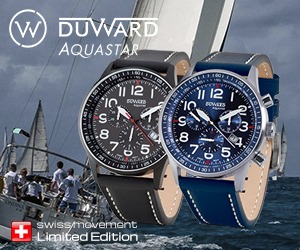
LATEST ARTICLES
Editor picks, nautic magazine and duward watches announce prestigious collaboration: introducing the aquastar summer sailing 2024 bcn edition, canadian beau lake introduces the tahoe ’14 and lugano ’14 electric runabouts, underwater adventure and exploration with deepflight’s super falcon 3s, popular posts, mirabaud sailing video of the century: celebrating 2 decades of passion, young designer of the year 2022: ioana valentina corcodel reveals 65m ophelia concept, the nacra15 world championships open in la grande motte, france, popular category.
- Regatta 841
- America's Cup 492
- Motor Yachts 264
- Boating 220
- Superyachts 191
- Sailing 184
- Yachts News 174
- Sailing Yachts 167

Boat of the Year 2020 F101: Best Foiler
- By Dave Reed
- Updated: December 10, 2019
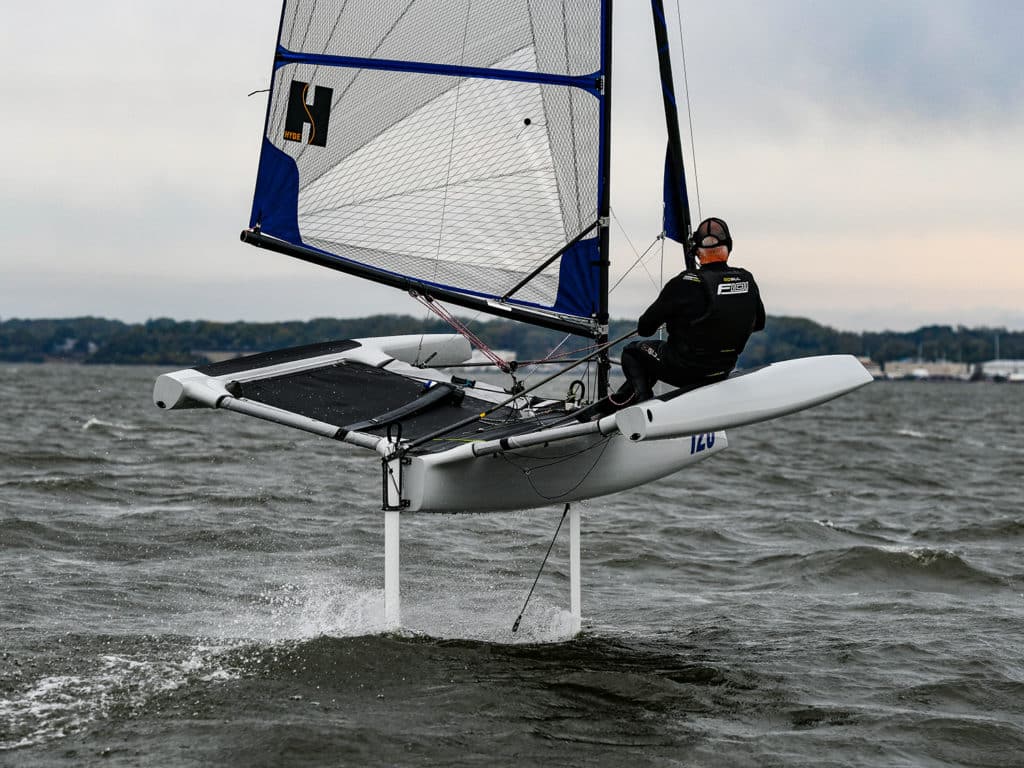
At A Glance
Price As Sailed: $24,750
Design Purpose: Learn to foil, advance skills
Crew List: One or two
Rob Andrews and his business partner Alan Hillman have been teaching foiling for a few years now, and one thing they’ve learned is we get better by sailing, not by swimming. Thus was the genesis of the F101, a craft with which they could teach the fundamentals of foiling—without the crash and burn. But it’s not just a learn-to-foil boat, either. It’s a platform with which new and experienced converts alike can take their foiling skill set to a higher level.
The key to mastering the F101, Andrews explains, is grasping righting moment. With the trimaran platform, you get plenty of it, as well as a stable boat that’s more forgiving than any other small foiler. “The trimaran configuration gives you righting moment direct from the foil in the middle hull,” he says, “and gives a measure of safety. It’s hard to capsize the boat.”
The judges learn as much when it comes time to sail the F101. In 15 knots and more, and a steep Chesapeake chop, Powlison is first to give it a go. He settles into the boat, gets his bearings, perches skittishly on the weather hull, sheets on the mainsail (no need to use the boat’s gennaker above 12 knots) and off he goes like a bat out of hell, popping up on the foils without even trying.
“The trick is getting used to the sensation of heeling to windward,” he says. “It takes a bit of trust. Once foiling, it’s quiet and fast, and I felt like I had to be really active on the mainsheet to keep it on the foils.”
That’s true of any foiler, but the beauty of the F101, the judges agree, is when you do lose it, it’s no big deal. The boat drops off its foils, the bows auger in and you get a face full of water; but just reset, bear away and try again.
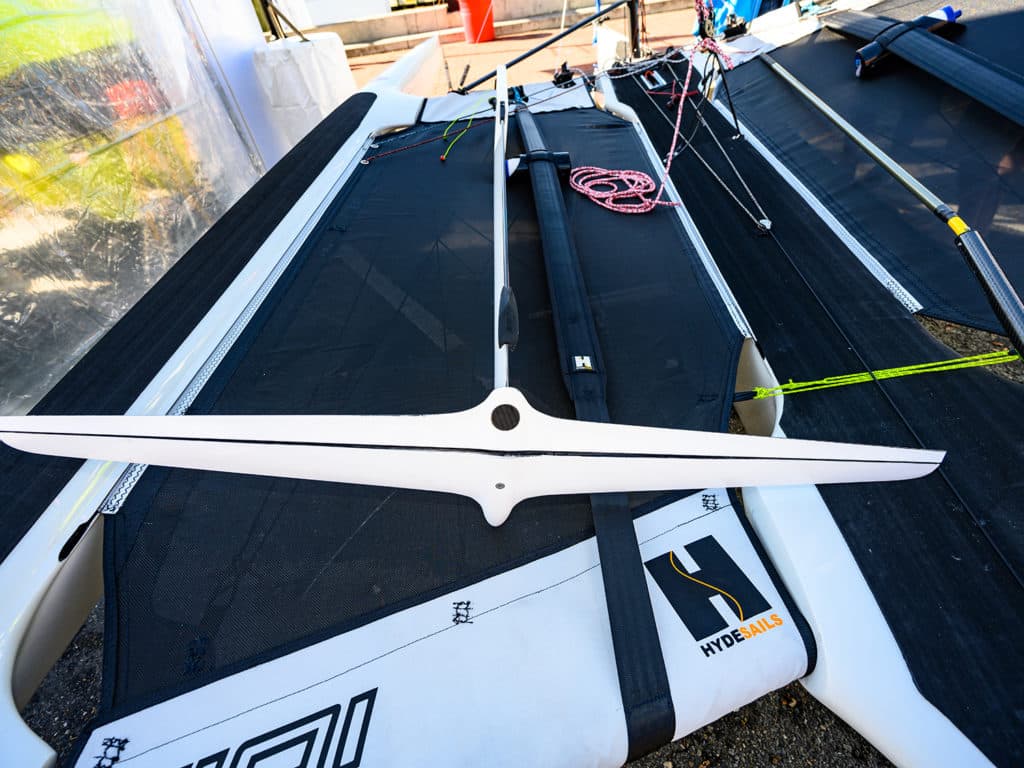
“The hull shape picks up the buoyancy gently,” Stewart says, “which makes it depress smoothly and prevents it from pitchpoling. When I dumped it a few times I thought I was going in, but not a chance. You quickly realize there’s plenty of floatation there to save you. In flat water, with one day of training you’d get up to speed quickly.”
When teaching people to foil, Hillman starts with “skimming,” a ride height barely above the surface. As the sailor becomes more accustomed to how the boat behaves, there’s a simple line adjustment at the foil head: Dial it up one setting and increase your ride height.
As you’re sailing, the foil wand hanging behind the trailing edge effectively feels where the boat is riding relative to the water and actuates the main flap. In light winds, it gives you more lift, and the boat pops up on the foil. Get too high, and the wand drops down even further, forcing negative lift on the flap, which brings you back down to your desired height and prevents the foils from breaking the surface.
In terms of construction, the judges praise its carbon-and-epoxy build quality and the all-up weight of 180 pounds, which makes it easy to get to and from the water. With the F101 sitting on its dolly in the boat park, going sailing is as simple as pulling back the covers, hoisting the main and launching from a dock, beach or boat ramp with minimal fuss.
“What I like about it is that it’s one of those boats that you buy and don’t need to add anything to it,” Allen says. “There’s nothing to change out or upgrade.”
For simplicity, the boat is set up with adjustments that let you ratchet up the experience as you climb the learning curve. On the rudder foil, for example, there is a clear numbering system so that as you twist the tiller extension, you change the rudder rake. The baseline setting is zero, and it’s the same for the main foil. The only thing left is to balance the forces with the mainsheet.
“When I first got up on the foils, I was thinking to myself, ‘This is too easy; I should be working harder,’ ” Powlison says. “As they said, this boat solves a lot of the problems associated with other foiling dinghies. It’s a great high-performance boat that represents the next step in making foiling accessible to the public.”
See All Winners
Other Winners:
- 2020 Boat of the Year
- Best Crossover
- Best Multihull
- Best Foiler
- Best Dinghy
- More: BOTY , boty 2020 , foils , Sailboats
- More Sailboats
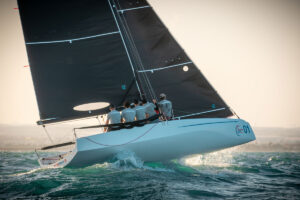
Sporty and Simple is the ClubSwan 28

Nautor Swan Has A New Pocket Rocket

Pogo Launches its Latest Coastal Rocket

A Deeper Dive Into the Storm 18
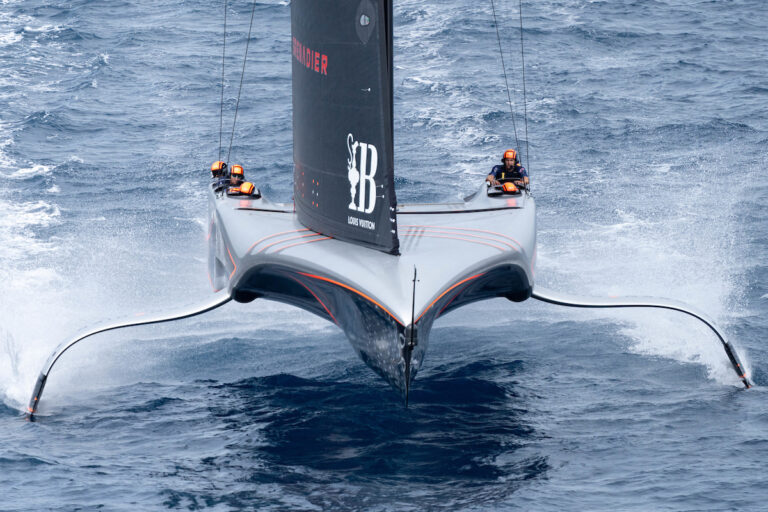
Barcelona Breeze Increase Spikes Intensity

Luna Rossa Dominant on Busy Day in Barcelona
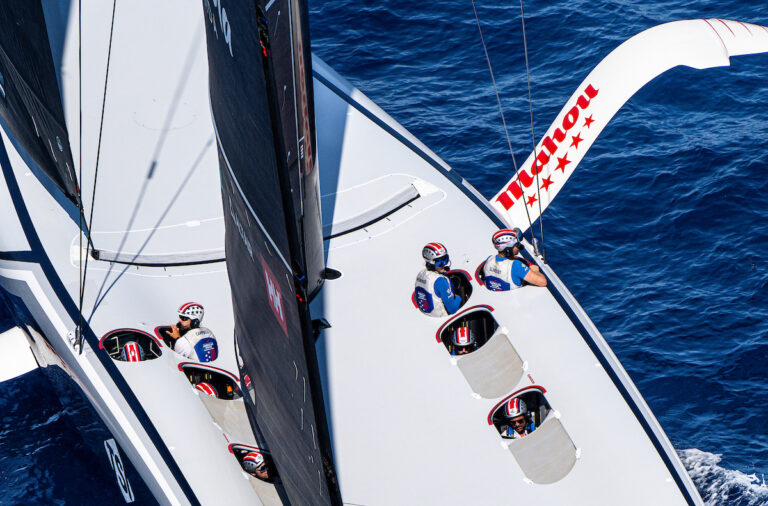
One and Done on Drifter Day of Cup Challenger Series
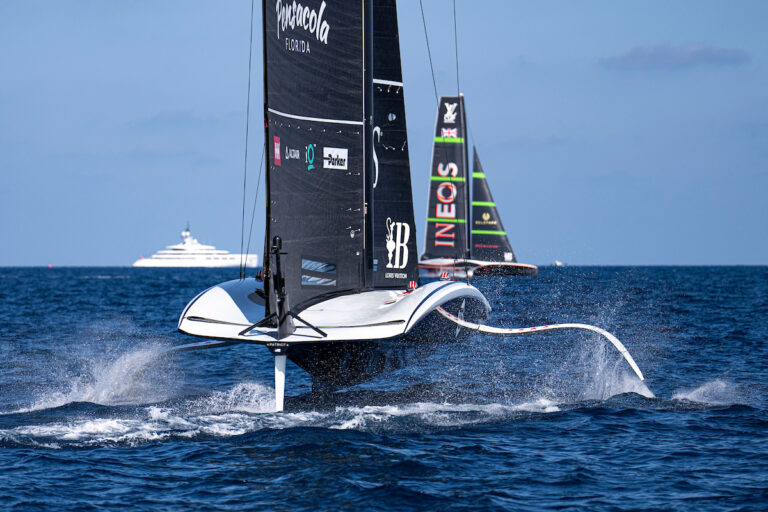
Shocks and Drops At Louis Vuitton Cup Start

- Digital Edition
- Customer Service
- Privacy Policy
- Terms of Use
- Cruising World
- Sailing World
- Salt Water Sportsman
- Sport Fishing
- Wakeboarding

Home » Blog » Sail » Hydrofoil boats for the rest of us
Hydrofoil boats for the rest of us
By Author Fiona McGlynn
Posted on Last updated: August 18, 2023
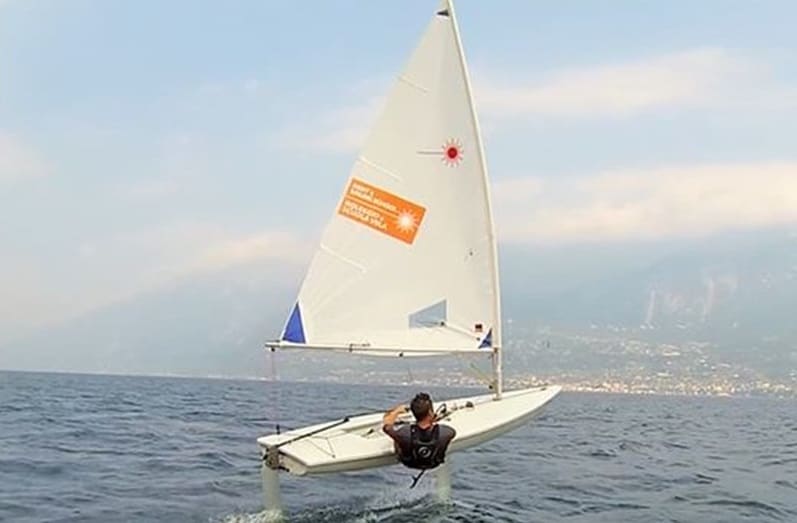
Glide Free Foils Laser on foils. Photo credit: sailboats.co.uk ,
Watching foiling boats fly around the America’s Cup race course, is enough to quicken any sailor’s pulse. But unless you’ve got a spare few million kicking around, most hydrofoil boats are still very much out of the average boater’s budget . There are however a few ways to experience the magic of foiling without racing towards bankruptcy.
HOW DOES HYDROFOILING WORK?
Much in the same way that air flows over and under aircraft wings to create lift, water flowing around a hydrofoil lifts a boat’s hull out of the water . Once the greater part of the boat’s surface area is out of the water, friction is greatly reduced and the boat can “fly” at faster speeds .
How fast? The 2021 America’s Cup AC75s are expected to reach top speeds of 40 to 50 knots!
Like sails, foils are not a matter of “set it and forget it”, instead the foil-attitude must be adjusted to keep the boat in flight . On the 2017 America’s Cup boats these adjustments were made by the skipper/helmsman but powered (via a hydraulic system) by crew grinding winches (or in New Zealand’s case, pedal bikes ).
Because we don’t all have Jimmy Spithill ‘s magic touch, developing highly sophisticated flight control systems is key to bringing foiling into mainstream boating. Candela, a new 25-foot production e-foiling powerboat (and 2019 Best of Boats award winner) offers such a solution with foils that change position 100 times per second! Still, at ~$240,000 it’s well beyond most boating budgets.
Fortunately, smaller foilers (dinghies and boards) don’t require high tech flight control systems and are far less expensive . Here are a few options for (more) affordable foiling:
HYDROFOIL DINGHIES
Laser foiling kits.
Clip a foil onto your Laser and fly over the surface of the water. Two Australian based companies, Foilsz and Glide Free Foils , offer Laser foiling kits. The Glide Free kit doesn’t require any permanent fixtures, so you can easily remove it (for those days when you’re in a displacement mode mood). They say that speeds of 18-25 knots are possible with their kit, which sells for just under $4,530 AUD (~$3,00 USD).
UFO foiling multihull
For a few bucks more you can buy a foiling catamaran. The UFO was launched in 2017 and can fly at 15-20 knots. With a price tag of $7,000, it may be the most economical multihull foiler on the market.
Take a foiling course
Some clubs and community sailing programs are adding foilers to their fleets. For example Nantucket Community Sailing offers a 3-hour semi-private class for $100 per person . Or if you’re looking for a more exotic locale, the Provela Foiling Centre in Spain offers a range of foiling classes from beginner to advanced. Their two-day “Try Fly – Foiling” class costs 200 euros and their fleet includes Foiling Moths, White Formula Whispers, WASPZs, and F101s.
HYDROFOIL KITEBOARDS
It’s not like kiteboards are sluggish to begin with, but hydrofoil boards take the sport to a whole new level, delivering speeds of 40 miles an hour ! By using a foil to lift their boards out of the water, foiling kiteboard enthusiasts get an exceptionally quiet and smooth ride – so much so, that kiteboard riders in Silicon Valley have been spotted taking calls on their cell phones. Set up costs start at around $1,000. Take a foil boarding course and buy protective gear, this extreme water sport is not for the faint of heart.
HYDROFOIL WINDSURF BOARDS
Foiling is taking off in the windsurfing world with world champions like Robby Naish and Atoine Albeau leading the charge. It has been confirmed that windfoiling will be a class at the 2024 Olympics in Paris . Set up costs start around $2,500.
With foiling technology trickling down into the mainstream, you can expect to see more and more high speed foiling boats and boards on the water . Is foiling the future? Let us know what you think in the comments below.
Fiona McGlynn is an award-winning boating writer who created Waterborne as a place to learn about living aboard and traveling the world by sailboat. She has written for boating magazines including BoatUS, SAIL, Cruising World, and Good Old Boat. She’s also a contributing editor at Good Old Boat and BoatUS Magazine. In 2017, Fiona and her husband completed a 3-year, 13,000-mile voyage from Vancouver to Mexico to Australia on their 35-foot sailboat.
Terms and Conditions - Privacy Policy

Discover the Magic of Hydrofoil Sailboats

Key Takeaways
- Hydrofoil sailboats blend speed, stability, and innovation for a fun sailing experience.
- Their design lifts the hull above water, reducing drag and enabling high-speed travel.
- Advanced control mechanisms maintain stability in varying wind conditions.
- Sails and hulls are meticulously engineered for optimal aerodynamics and lift.
- Ongoing innovations in foil technology continue to propel hydrofoils to new heights.
Based on their innovation and nature, the world of hydrofoil sailboats are magical, to say the least. But what exactly makes them so exceptional?
The magic of hydrofoil sailboats lies in their extraordinary speed. They can achieve remarkable speeds that were once thought impossible for sailboats. Their unrivaled stability and cutting-edge technology redefine sailing, offering a thrilling blend of innovation and performance.
Over the years, I've dedicated myself to mastering the intricacies of the yachting world, not just as an observer but as an active participant in the hydrofoil sailing community. My knowledge extends beyond the surface, encompassing the technical aspects of hydrofoil design and the thrill of high-speed sailing. As such, I’ll provide a comprehensive and engaging exploration of what sets hydrofoil sailboats apart, making them truly magical on the waters.
Table of contents
Discover the Magic of Hydrofoil Sailboats
Hydrofoils saw their early development as a concept for enhancing speed and efficiency on the water. From Alexander Graham Bell's experiments to the application of foils on sailboats in the 1950s, the quest has always been for greater speed.
But it wasn't until Russell Long championed these designs with the CEC foiling catamaran and the development of the Hobie Trifoiler that hydrofoils began to carve a distinct niche in the sailing world.
This sailboat operates on a simple yet ingenious principle: as the speed increases, the foils submerged beneath the boat generate lift. This lift thrusts the boat's hull above the water, dramatically reducing drag.
It’s similar to how air flows around the wing of an airplane, only with water's denser environment offering a different dynamic. This revolutionary foiling system allows boats to glide over waves, offering an incredibly smooth ride.
The variety of hydrofoil sailboats is astounding, from the foiling catamarans that have revolutionized the America's Cup to the twin sail trimaran designs. The fastest production sailboat, the Hobie Trifoiler , showcases what hydrofoils are capable of.
Additionally, boats like the innovative Emirates Team New Zealand vessels continue to push the boundaries of technology in competitive sailing. Whether for recreational purposes or high-speed racing, the range of hydrofoil sailboats caters to different sailing experiences and preferences.
Now, let’s explore the various aspects of hydrofoil sailboats that make them truly magical.
The Thrills of Hydrofoil Sailing
When I first stepped onto a hydrofoil sailboat, I knew that sailing would never be the same for me. Harnessing the power of the wind to achieve remarkable speeds while hovering above the water was nothing short of revolutionary.
It's an adrenaline-infused blend of sailing, flying, and innovation that promises high performance and stability with a significant reduction in wetted areas.
The allure of hydrofoiling is not just about the speed; it's the sensation of flying over the waves, defying the conventions of traditional sailing. With each gust, my hydrofoil sailboat becomes a silent, swift car, slicing through the air rather than merely sailing on the water.
When sailing with hydrofoils, you get to experience the following benefits.
- High Speed: With hydrofoils, I've seen and achieved speeds I never thought possible on water.
- Less Wetted Area: As the hydrofoils lift the hull out of the water, drag is reduced, further contributing to the craft's efficiency and speed.
- Stability: Surprisingly, the flying sensation is accompanied by stability once airborne, making the ride smoother.
The America’s Cup Competitive Foiling
Over the years, I've witnessed first-hand how hydrofoil technology has radically altered the landscape of competitive sailing. The introduction of hydrofoils has not only redefined what we consider possible in the sail area but has also brought a fresh surge of excitement to the racing circuit.
The most illustrious event in sailing, the America's Cup , underwent a transformation with the embrace of hydrofoils. Emirates Team New Zealand, a frontrunner in hydrofoil innovation, redefined the America's Cup racing in 2017.
Alongside them, the US team and Luna Rossa played pivotal roles in reshaping the landscape of America's Cup racing.
With their AC50 class catamarans soaring above the waves at top speeds that defy traditional sailing limits, they clinched the title and shifted the focus of competitive racing toward technological prowess.
The spectacle of these vessels racing is not just about the crew's capabilities but equally a testament to engineering marvels.
Also, the advent of hydrofoils in racing has certainly led to a spike in performance metrics. Here's a concise table highlighting the before and after impact of hydrofoiling in competitive Sailing:
| Aspect of Racing | Before Hydrofoiling | After Hydrofoiling |
|---|---|---|
| Top Speed | Limited by hull drag and water resistance | Drastically increased due to reduced drag |
| Crew Skills | Traditional sailing techniques | Advanced agility and dynamic sailing are required |
| Race Dynamics | Heavily dependent on wind | Enhanced control and strategy with stable wind conditions |
| Teams' Focus | Conventional sail trimming | Precision in foil control and balance |
This table illustrates just how much the racing landscape has shifted; it's not only sailing anymore.
It’s similar to piloting a high-speed aircraft, with each crew member playing a crucial role in harnessing the raw power of the strong winds in harmony with state-of-the-art technology. Watch this video for a more detailed explanation of hydrofoil sailboats and their magical power.
Technical Aspects of Hydrofoil Sailboats
In diving into the technical aspects of hydrofoil sailboats, I'll give you an insight into the intricate designs that enable these marvels to glide above the water, as well as the cutting-edge foil technology propelling them.
The design of a hydrofoil sailboat revolves around its capability to elevate the hull above the water, reducing drag and enabling high wind-speed travel. Control mechanisms are central in maintaining stability, especially when the sailboat interacts with varying wind conditions or maneuvers through shallow waters.
The hull's length and overall design are calibrated for balancing aerodynamics with hydrodynamics. In designing sails and hulls for foiling, one must carefully balance the need for power with the propensity for lift.
The sails are tailored not only to harness the wind's energy effectively but also to match the unique mechanics of a vessel in flight. Meticulous engineering ensures that the sail configuration works in harmony with the foils to propel the sailboat forward swiftly.
Additionally, the foil technology, which is pivotal to modern hydrofoils, has undergone significant further development over the years . From the materials used to the manufacturing processes, every element incorporates the latest in technology to yield extreme performance.
Advancements have led to foils that can automatically adjust to sailing conditions and speed, which is instrumental for achieving and maintaining high speeds.
Currently, the future of hydrofoil technology seems bound for even further breakthroughs. Customization and refinement of foils for specific water conditions, such as the challenges posed by shallow water, are ongoing.
Each new iteration builds upon the last, consistently advancing the field and informing the next leap in hydrofoil sailing. This persistent innovation in foil and hull technology is a testament to the potential that lies ahead for hydrofoil sailboats.
Are Hydrofoil Sailboats the Right Options for You?
Hydrofoil sailboats offer a unique and thrilling sailing experience, but whether they are the right option depends on your preferences and goals. These high-performance vessels are known for their exceptional speed and stability, making them ideal for thrill-seekers and competitive sailors.
If you're passionate about cutting-edge technology and want to push the boundaries of traditional sailing, hydrofoil sailboats could be a perfect fit.
However, they may require a learning curve for beginners and are typically more expensive than traditional sailboats.
Consider your skill level, budget, and desire for speed and innovation when deciding if hydrofoil sailboats align with your sailing aspirations.
The Future of Hydrofoil Sailboats and Their Transformative Potential
Over the years, I've been captivated by the evolution of sailing and the recent advancements in hydrofoil technology, which promise a thrilling future for these marine crafts.
The technology supporting hydrofoil sailboats is rapidly advancing, bringing us closer to a world where boats gliding above the water's surface is a common sight.
These boats use 'wings' or foils submerged in water to lift the hull above the surface, reducing drag and allowing for greater speeds. This innovation is not just limited to racing but is expected to influence recreational and transport vessels in the future.
Today, we see hydrofoils in action with hydrofoil kiteboards, which have become popular among thrill-seekers. This is due to their ability to harness wind power and achieve impressive acceleration and agility on the water. This same principle is being applied to larger sailing vessels, where performance and sustainability converge.
The further development of hydrofoil technology involves intensive research into materials and design optimizations that can handle the challenges of varied sea conditions.
Electric and solar-powered hydrofoils are on the horizon, poised to significantly impact our world by offering greener alternatives to traditional boats.
Notably, the trends in hydrofoiling indicate a shift towards more sustainable sailing, utilizing advancements in electric propulsion systems to complement the inherent energy efficiency of hydrofoil designs.
The goal is a fleet of sailboats that are not just faster but more eco-friendly, promising an exciting future where the joy of sailing is in harmony with the health of our oceans.
Related Articles
Daniel Wade
I've personally had thousands of questions about sailing and sailboats over the years. As I learn and experience sailing, and the community, I share the answers that work and make sense to me, here on Life of Sailing.
by this author
Learn About Sailboats
Most Recent

Affordable Sailboats You Can Build at Home
September 13, 2023

Best Small Sailboat Ornaments
September 12, 2023
Important Legal Info
Lifeofsailing.com is a participant in the Amazon Services LLC Associates Program, an affiliate advertising program designed to provide a means for sites to earn advertising fees by advertising and linking to Amazon. This site also participates in other affiliate programs and is compensated for referring traffic and business to these companies.
Similar Posts

Hunter Sailboats: Are They Built for Bluewater Cruising?
August 29, 2023

What Is A Furler On A Sailboat?
August 22, 2023

What Is Sail Roach?
August 15, 2023
Popular Posts

Best Liveaboard Catamaran Sailboats
December 28, 2023

Can a Novice Sail Around the World?
Elizabeth O'Malley
June 15, 2022

4 Best Electric Outboard Motors

How Long Did It Take The Vikings To Sail To England?

10 Best Sailboat Brands (And Why)
December 20, 2023

7 Best Places To Liveaboard A Sailboat
Get the best sailing content.
Top Rated Posts
© 2024 Life of Sailing Email: [email protected] Address: 11816 Inwood Rd #3024 Dallas, TX 75244 Disclaimer Privacy Policy

Support our hydrofoil educational content for free when you purchase through links on our site. Learn more
[2023] Hydrofoil Catamaran: The Ultimate Guide to Foiling on Water
- November 1, 2023
- Hydrofoil Basics
Experience the thrill of flying above the water with a hydrofoil catamaran!
Are you ready to take your hydrofoil boarding to the next level? Look no further than the hydrofoil catamaran. In this comprehensive guide, we’ll dive deep into the world of hydrofoil catamarans, exploring their history, how they work, their benefits and drawbacks, and everything else you need to know to make an informed decision. So, buckle up and get ready to soar above the waves!
Table of Contents
Quick answer, quick tips and facts, how does a hydrofoil catamaran work, benefits of hydrofoil catamarans, drawbacks of hydrofoil catamarans, choosing the right hydrofoil catamaran, maintenance and care, recommended links, reference links.
A hydrofoil catamaran is a type of watercraft that combines the stability of a catamaran with the lift and speed of hydrofoils. It uses specially designed foils to lift the hulls out of the water, reducing drag and allowing for faster and smoother sailing. Hydrofoil catamarans are popular among sailors and water sports enthusiasts for their incredible speed, maneuverability, and thrilling foiling experience.
Shopping Links: Hydrofoil Catamarans on Amazon | Hydrofoil Catamarans on Walmart | Hydrofoil Catamarans on Etsy
- Hydrofoil catamarans can reach speeds of up to 40 knots (46 mph) or more, depending on the design and conditions.
- The foils on a hydrofoil catamaran can lift the hulls out of the water, reducing drag and allowing for a smoother and faster ride.
- Hydrofoil catamarans are used for various purposes, including racing, recreational sailing, and even transportation.
- Foiling on a hydrofoil catamaran requires some skill and practice, but it’s an exhilarating experience once you get the hang of it.
- Hydrofoil catamarans come in different sizes and designs, catering to different skill levels and preferences.
Hydrofoil catamarans have a fascinating history that dates back to the early 20th century. The concept of using hydrofoils to lift boats out of the water and reduce drag was first explored by Italian engineer Enrico Forlanini in the late 1800s. However, it wasn’t until the 1950s that hydrofoil technology started to gain traction in the boating world.
The first hydrofoil catamaran, known as the “Aquavion,” was developed by the French engineer René Guilbaud in the 1950s. This innovative design combined the stability of a catamaran with the lift of hydrofoils, revolutionizing the world of sailing. Since then, hydrofoil catamarans have evolved and become more advanced, offering incredible speed, maneuverability, and stability on the water.
A hydrofoil catamaran works by utilizing hydrofoils, which are wing-like structures mounted underneath the hulls of the boat. These foils generate lift as the boat gains speed, lifting the hulls out of the water and reducing drag. This lift allows the hydrofoil catamaran to achieve higher speeds and a smoother ride compared to traditional boats.
The hydrofoils on a catamaran are typically designed with a curved shape, similar to an airplane wing. This shape creates a pressure difference between the upper and lower surfaces of the foil, generating lift. The foils are usually adjustable, allowing the sailor to fine-tune the performance of the catamaran based on the sailing conditions.
To control the hydrofoil catamaran, sailors use a combination of steering and sail trim. By adjusting the angle of the foils and the sails, they can optimize the lift and balance of the boat, ensuring a stable and efficient ride. It takes some practice to master the art of foiling on a hydrofoil catamaran, but the rewards are well worth the effort.
Hydrofoil catamarans offer a range of benefits that make them a popular choice among sailors and water sports enthusiasts. Here are some of the key advantages of hydrofoil catamarans:
Speed : Hydrofoil catamarans are known for their incredible speed. By lifting the hulls out of the water, hydrofoils reduce drag and allow the boat to glide smoothly above the waves. This enables hydrofoil catamarans to reach impressive speeds, making them a thrilling choice for racing and high-performance sailing.
Maneuverability : The lift generated by hydrofoils enhances the maneuverability of catamarans. With reduced drag, hydrofoil catamarans can make sharp turns and quick maneuvers with ease. This agility is particularly useful in racing scenarios, where every second counts.
Stability : The dual-hull design of catamarans provides inherent stability, even at high speeds. When combined with hydrofoils, the stability of hydrofoil catamarans is further enhanced. This stability makes them suitable for sailors of all skill levels, from beginners to experienced professionals.
Efficiency : Hydrofoil catamarans are more efficient than traditional boats. By reducing drag, hydrofoils allow the boat to sail faster while using less power. This increased efficiency translates to longer sailing distances and reduced fuel consumption, making hydrofoil catamarans an environmentally friendly choice.
Versatility : Hydrofoil catamarans are versatile watercraft that can be used for various purposes. Whether you’re looking for a high-performance racing catamaran or a recreational sailboat for family outings, there’s a hydrofoil catamaran to suit your needs. Some models even offer the option to switch between foiling and non-foiling modes, providing flexibility on the water.
While hydrofoil catamarans offer numerous benefits, it’s important to consider their drawbacks as well. Here are a few potential downsides to keep in mind:
Cost : Hydrofoil catamarans tend to be more expensive than traditional boats. The advanced technology and materials used in their construction contribute to the higher price tag. Additionally, maintenance and repairs can also be costly, especially if specialized parts or services are required.
Learning Curve : Foiling on a hydrofoil catamaran requires some skill and practice. It can take time to learn how to control the boat effectively and maintain stability while flying above the water. Beginners may find the learning curve steep, but with dedication and proper instruction, anyone can master the art of hydrofoil catamaran sailing.
Weather Conditions : Hydrofoil catamarans are sensitive to weather conditions. While they excel in flat water and moderate winds, rough seas and strong gusts can pose challenges. It’s important to be aware of the weather forecast and choose suitable sailing conditions to ensure a safe and enjoyable experience.
Transportation and Storage : Hydrofoil catamarans can be larger and bulkier than traditional boats, making transportation and storage more challenging. Specialized trailers or racks may be required to transport the catamaran, and adequate storage space is needed to protect it when not in use.
Despite these drawbacks, the thrill and excitement of foiling on a hydrofoil catamaran outweigh the challenges for many sailing enthusiasts.
When it comes to choosing the right hydrofoil catamaran, there are several factors to consider. Here are some key points to keep in mind:
Skill Level : Consider your skill level and experience as a sailor. Some hydrofoil catamarans are designed for advanced sailors, while others are more beginner-friendly. Choose a catamaran that matches your skill level to ensure a safe and enjoyable sailing experience.
Intended Use : Determine how you plan to use the hydrofoil catamaran. Are you looking for a racing catamaran, a recreational sailboat, or something in between? Different models offer varying features and performance characteristics, so it’s essential to choose a catamaran that aligns with your intended use.
Budget : Set a budget for your hydrofoil catamaran purchase. Prices can vary significantly depending on the brand, model, and features. Consider both the upfront cost and the long-term maintenance expenses when determining your budget.
Brand and Reputation : Research different brands and their reputation in the hydrofoil catamaran industry. Look for brands with a track record of producing high-quality, reliable catamarans. Reading customer reviews and seeking recommendations from experienced sailors can also provide valuable insights.
Demo and Test Sails : Whenever possible, try out different hydrofoil catamarans before making a final decision. Many manufacturers and dealers offer demo and test sails, allowing you to experience the performance and handling of the catamaran firsthand. This hands-on experience can help you make an informed choice.
Remember, choosing the right hydrofoil catamaran is a personal decision that depends on your individual preferences and needs. Take your time, do your research, and consult with experts to find the perfect catamaran for your hydrofoil adventures.
Proper maintenance and care are essential to keep your hydrofoil catamaran in top shape and ensure its longevity. Here are some maintenance tips to help you keep your catamaran performing at its best:
Rinse with Fresh Water : After each sailing session, rinse your hydrofoil catamaran with fresh water to remove salt and debris. Pay special attention to the foils, as saltwater can cause corrosion over time.
Inspect for Damage : Regularly inspect your catamaran for any signs of damage or wear. Check the foils, hulls, rigging, and sails for any cracks, dents, or loose fittings. Address any issues promptly to prevent further damage.
Store Properly : When not in use, store your hydrofoil catamaran in a dry and secure location. If possible, keep it covered to protect it from the elements. Consider using a boat cover or storing it in a boat shed or garage.
Follow Manufacturer’s Guidelines : Follow the manufacturer’s guidelines for maintenance and care. Each catamaran may have specific recommendations for cleaning, lubrication, and other maintenance tasks. Adhering to these guidelines will help prolong the life of your catamaran.
Seek Professional Assistance : If you’re unsure about any maintenance tasks or need assistance, don’t hesitate to seek professional help. Local boatyards, sailing clubs, or authorized dealers can provide expert advice and services to keep your catamaran in optimal condition.
By following these maintenance tips and caring for your hydrofoil catamaran, you can enjoy many years of thrilling foiling adventures on the water.
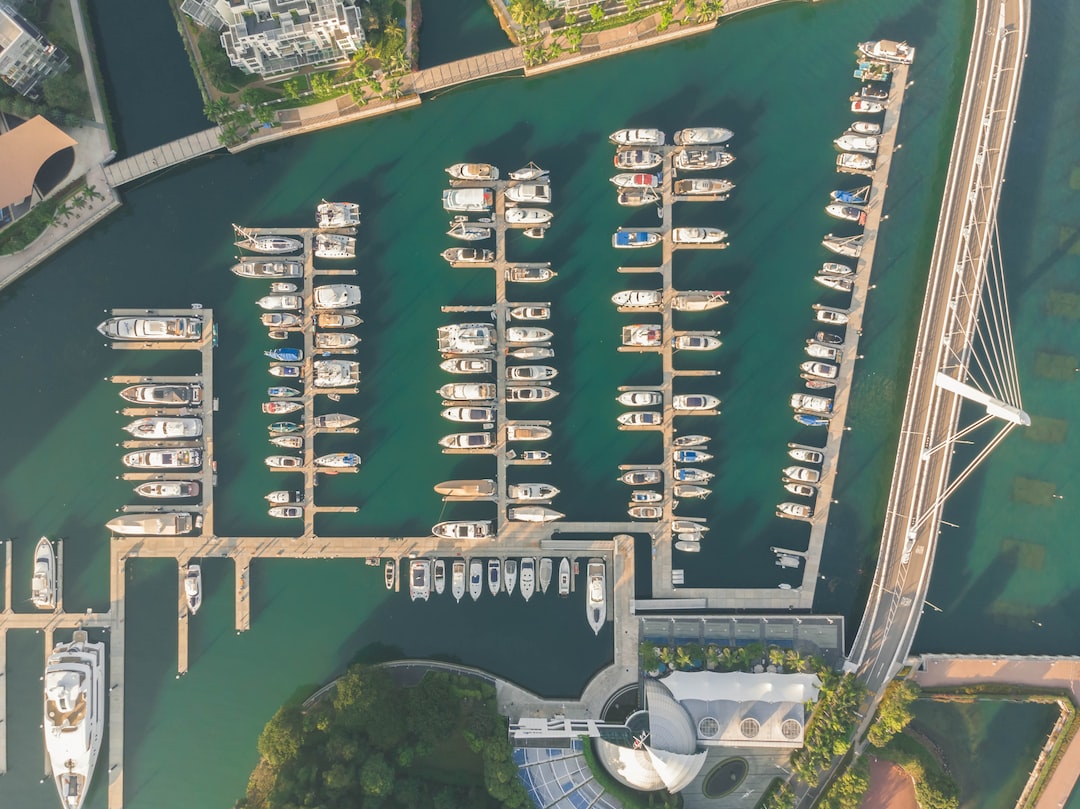
How fast is the hydrofoil catamaran?
Hydrofoil catamarans can reach impressive speeds, depending on various factors such as the design, wind conditions, and skill of the sailor. Some high-performance hydrofoil catamarans can exceed 40 knots (46 mph) or more. However, the exact speed will vary based on these factors.

How does a foil catamaran work?
A foil catamaran, also known as a hydrofoil catamaran, works by utilizing hydrofoils to lift the hulls out of the water. These foils generate lift as the boat gains speed, reducing drag and allowing for faster and smoother sailing. The lift created by the foils enables the catamaran to “fly” above the water, resulting in increased speed and improved performance.
What happened to hydrofoils?
Hydrofoils have a rich history and have been used in various applications, including passenger ferries, military vessels, and recreational boats. While hydrofoils experienced a surge in popularity in the mid-20th century, their use declined in some sectors due to factors such as high costs, maintenance challenges, and the development of alternative technologies. However, hydrofoils continue to be used in niche markets, including high-performance sailing and racing.
Read more about “… What is the World’s Largest Hydrofoil Boat?”
Are hydrofoil boats more efficient?
Yes, hydrofoil boats are generally more efficient than traditional boats. By lifting the hulls out of the water, hydrofoils reduce drag and allow the boat to sail faster while using less power. This increased efficiency translates to longer sailing distances and reduced fuel consumption. However, it’s important to note that the efficiency gains may vary depending on factors such as the design, sailing conditions, and skill of the sailor.
Hydrofoil catamarans offer an exhilarating and thrilling experience on the water. With their incredible speed, maneuverability, and stability, they have become a favorite among sailors and water sports enthusiasts. While they may come with a higher price tag and require some skill to master, the rewards of foiling on a hydrofoil catamaran are well worth it.
When choosing a hydrofoil catamaran, consider factors such as your skill level, intended use, budget, and the reputation of the brand. Take the time to research and test different models to find the perfect catamaran for your needs.
So, are you ready to take flight on a hydrofoil catamaran? Embrace the thrill, experience the freedom, and enjoy the incredible sensation of soaring above the water. Happy foiling!
- Hydrofoil History
- Advanced Hydrofoiling Techniques
- Hydrofoil Equipment Reviews
- Why do boats not use hydrofoils?
- iFLY15 – iFLY Razzor Pro – Foiling Catamaran
- Hydrofoil Catamarans on Amazon
- Hydrofoil Catamarans on Walmart
- Hydrofoil Catamarans on Etsy
Review Team
The Popular Brands Review Team is a collective of seasoned professionals boasting an extensive and varied portfolio in the field of product evaluation. Composed of experts with specialties across a myriad of industries, the team’s collective experience spans across numerous decades, allowing them a unique depth and breadth of understanding when it comes to reviewing different brands and products.
Leaders in their respective fields, the team's expertise ranges from technology and electronics to fashion, luxury goods, outdoor and sports equipment, and even food and beverages. Their years of dedication and acute understanding of their sectors have given them an uncanny ability to discern the most subtle nuances of product design, functionality, and overall quality.
Related Posts
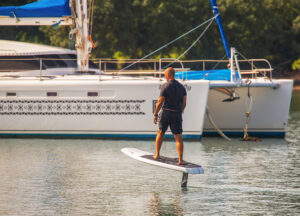
Can You Hydrofoil Without Waves? 10 Surprising Insights You Need to Know! [2024] 🌊
- August 28, 2024
The Ultimate Guide to Foiling Boards: 12 Secrets You Need to Know for an Epic Ride [2024] 🏄♂️
- August 24, 2024

How to Get Up on a Hydrofoil: 12 Essential Tips for Beginners [2024] 🏄♂️
Leave a reply cancel reply.
Your email address will not be published. Required fields are marked *
Add Comment *
Save my name, email, and website in this browser for the next time I comment.
Post Comment
Trending now

TF10 Foiling Trimaran
Ultra-modern, morrelli & melvin design, craftsmanship, wij bouwen uw nieuwe foiling boot, the tf10 trimaran: the foiling flying machine.
After the foiling revolution, the TF10 foiling trimaran is now the evolution of foiling sailing. With the TF10 foiling trimaran, sailing and foiling can be reached by any sailor. The TF10 is an 11 m long one-design foiling trimaran, designed by the famous yacht designers Morrelli & Melvin . The TF10 is built and sold by DNA Performance Sailing.
The TF10 is suitable for a crew of 4-5 persons and can handle a wide range of sailing conditions. The construction consists of pre-preg carbon fibers with a Nomex honeycomb core. This provides a lightweight, yet safe and robust construction. The foiling TF10 trimaran is the perfect foiling boat for both pleasure trips and sailing fast in races.
The transport of the TF10 is also revolutionary: when folded, it is easy to transport. We supply the TF10 with a specially designed road trailer, launching by boat ramp or crane are both possible.
Foils create sailing comfort
Thanks to the sophisticated design, every sailor feels comfortable on the TF10 foiling trimaran. Regardless of age, gender or muscle strength. And regardless of the speed, which can quickly reach up to 30 knots! Safety and comfort were the two main focuses of the design. This is reflected in a number of elements:
- The bow is designed to cut through the waves. This results in less hits on waves, which greatly increases sailing comfort.
- The carbon benches with back support provide a comfortable seat for crew and helmsman.
- The wishbone boom (half windsurfer boom) provides the decksweeper mainsail layout to perform at its best. An additional advantage is that in a manoeuvre the sail is now the lowest point and not the carbon boom.
- A ‘Semi-ridged’ carbon fibre trampoline cloth has been specially designed to make the boat’s construction torsional stiff. It makes it easier to walk on and block’s splashing water from the foils.
- The TF10’s foils and T-rudders minimize pitch and roll movements. The rake angle of all four foils is adjusted with electric actuators. This system improves comfort and safety during sailing and foiling.
TF10 hydrofoils
The TF10 foiling trimaran flies with a 4-point foil setup:
- The T-rudders with horizontal elevators generate lift and/or downforce.
- The so called Z-type daggerboard foils provide the necessary lift to be able to foil.
- The advantage of the 4-point-foil setup is that the crew does not have to pick up the daggerboards during manoeuvres. This significantly reduces the crew’s actions.
- In addition, we have electric actuators that change the position of the foils and rudders with a single push on the button.
- The design of the Z-foils has already been very successfully applied to other foiling multihulls, such as the A-cats and the Olympic Nacra 17.
Specifications
Length incl. bowsprit: 10.94 m Length waterline: 9.97 m Beam: 6.8 m Beam incl. benches: 7.65 m Beam (folded on trailer): 2.5 m Minimum draft: 0.4 m Maximum draft: 2.55 m Height center hull: 1.78 m Mast length: 16.1 m Displacement leightship: 1400 kg Displacement max. load: 1900 kg Outboard engine: 6pk, retractable Mainsail: North Sails 3Di 45 m2 Jib: North Sails 3Di 28 m2 Gennaker: (on furler) 71 m2 LED Navigation lights
Fast and pure one-design racing Easy shipping Created by owners for owners
See and feel the future of sailing. The TF10 foiling trimaran is here!
This special foiling trimaran was designed at the end of 2015. The idea was to make a foiling multihull that anybody can sail and foil with. A foiling boat equipped with the same technology as the boats at the America’s Cup.
The TF10 and its sailing class is the result of initiatives by a group of five sailing friends on the East Coast of America (Newport, RI). They have joined forces and created the TF10 sailing class.
The members of the TF10 Class Association have lot’s of experience in various one-design racing series. The goal is to create a racing series that is as exciting, honest and fun as the boat itself.
Morrelli & Melvin designed a trimaran to combine the specific characteristics of a trimaran with foiling. The trimaran’s center hull offers important advantages here: its buoyancy and pitch stability eliminate the risk of ‘nose diving’ or ‘pitch poling’. In the design briefing, wind range and sea state (short sea shipping) were important. The design of the TF10 is based on this.
For all information, competitions and the latest news, please visit the TF10 Class website: www.TF10class.com
It is possible to make a trial run with the TF10. We do this on the IJsselmeer, just a few kilometres from DNA’s shipyard. Here the sailing and foiling conditions are perfect: There is always wind and you can fully enjoy the beautiful surroundings. The IJsselmeer lies between the cities of Lelystad, Almere and Enkhuizen. The new island area “Markerwadden” can also be seen and possibly visited here. Mail us at [email protected]
Schrijf je in voor onze nieuwsbrief en blijf op de hoogte van de nieuwste ontwikkelingen!

Contactformulier
- Company Name
- Full name * First Last
- Emailaddress *
- Phonenumber *
- Mijn vraag betreft * My question: TF10 F1x G4 F4 Custom Parts Hydrofoils Other
- Email This field is for validation purposes and should be left unchanged.
Registrieren Sie sich für unseren Newsletter
lassen Sie sich über die neuesten Entwicklungen informieren!
- E-Mail-Adresse *
- Comments This field is for validation purposes and should be left unchanged.
Schrijf je in voor onze nieuwsbrief
blijf op de hoogte van de nieuwste ontwikkelingen!
- First name *
- Last name *
- Name This field is for validation purposes and should be left unchanged.
Wij gebruiken cookies om u de beste online ervaring te bieden. Door akkoord te gaan, accepteert u het gebruik van cookies in overeenstemming met ons cookiebeleid.
Wanneer u een website bezoekt, kan deze informatie in uw browser opslaan of ophalen, meestal in de vorm van cookies. Beheer hier uw persoonlijke cookiediensten.
- wordpress_test_cookie
- wordpress_logged_in_
- wordpress_sec

Published on June 2nd, 2017 | by Assoc Editor
Foiling and Foil Shapes, a Beginner’s Guide
Published on June 2nd, 2017 by Assoc Editor -->
by Mark Chisnell, Land Rover BAR The rules covering the design and construction of the team’s America’s Cup Class (ACC) boat have defined many of the parts of the boat, including the hull and crossbeams (together called the platform), and the wing shape and size. What’s left for the team’s designers and engineers to work on is principally the daggerboards and rudders, and the control systems that operate them along with the wingsail.
A lot of the technology that goes into the control systems is hidden well inside the hull, with just glimpses of the HMI (human machine interface) that the sailors use to control the board rake, wing trim and so on. The foils are on full view however, so we thought a beginners guide to ACC foil design would come in useful now the racing is approaching.
Basic Principles The foils use exactly the same scientific principles as an aircraft wing. Just as an aircraft wing will lift a plane up off the ground, the foils of an America’s Cup Class boat will lift it out of the water. Wings are foils too, called aerofoils because they work in air. The foils on the new America’s Cup boats are more accurately called hydrofoils, because they work in water.
The secret to both types of foil is the shape – aerofoils and hydrofoils use a special shape to guide the wind or water around them, and generate the lifting force to get planes and boats up in the air. Of course, the America’s Cup boats also use an aerofoil. The main wingsail works exactly the same way as an aircraft wing, it’s just rotated to stand up straight, rather than lie flat.

While an aircraft needs an engine to push the air over the wing fast enough to generate enough force to lift the aircraft up off the ground, the wingsail on the Cup boat generates force from the wind blowing past it. The harder the wind blows, the more force it makes to push the boat forward. When the boat is going fast enough, the hydrofoils will then be able to create enough force to lift the boat out of the water. This reduces resistance to the forward motion and the boat goes faster still.
There are four hydrofoils on the boat — we count the rudders at the back because they have small wings at the tips called elevators. However, the real power to keep the boat in the air comes from the hydrofoils (the daggerboards, as you will often hear them called by the sailors) and we will concentrate on these.
The L-Foil The L-foil is exactly that; a vertical daggerboard shaft that goes through the hull of the boat, with a single horizontal hydrofoil on the bottom, the whole thing shaped like an ‘L’. If nothing else changes, then the L-foil keeps generating lift as the boat goes faster and so the boat keeps rising, and as it rises, less and less of the daggerboard is in the water.
At the basic level, two things then happen: firstly, the boat starts to slip sideways because there is less of the vertical part of the daggerboard in the water and this makes the boat feel unstable and hard to steer. Then, ultimately, if the boat keeps rising the horizontal part of the board that is doing all the lifting will break the surface. If it does, there will be a catastrophic loss of lift and the boat will come crashing back down.
Aircraft use moving parts on the foils to control the amount of lift – trailing edge flaps — but the rules forbid these on the ACC boats, so to maintain stable flight the sailors change the rake or angle of attack of the whole dagger board (and hence the foil) to the water.
Rake If you rake the board backwards as the boat accelerates, the lift will reduce and the boat will come to an equilibrium at a steady height above the water. This is all well and good until the conditions change, maybe the wind speed goes up or down, or the boat hits some waves. When that happens the rake will need further adjustment to find the new equilibrium… until the next puff or lull when it must change again.
In the big breeze and rough water of San Francisco Bay in the 34th America’s Cup it turned out that these moments of equilibrium didn’t last very long and on occasions barely existed at all. The crew’s ability to generate the hydraulic power to change the board and wing trim was simply overwhelmed; they couldn’t achieve stable flight.
V-foil The solution was what’s called the V-foil, in which the horizontal part of the ‘L’ is angled upwards to form more of a ‘V’ shape (the angle at the bottom of the ‘V’ is called the dihedral – a dihedral of 90 degrees would define an L-foil, less than that is progressively more of a V-foil).
The V-foil uses the same principle as one of the most successful original foiling powerboats. The grand old man of 19th century innovation, Alexander Graham Bell put a couple of 350hp engines on the back of what was called HD-4 and set a new marine world speed record in 1919 of just over 70mph.
HD-4 used three ‘ladders’ of small foils, one at the front, and one each side close to the back. When the boat accelerated it started to lift out of the water, and as it lifted, one by one the ‘rungs’ of the foils would break clear of the water. As they did so the lift would decrease, and unless the boat continued to accelerate the boat would stop rising and settle at an equilibrium.
The V-foil achieves this same effect with a single foil and is used in the commercial application of fast ferries— one runs between Southampton and Cowes on the Isle of Wight, right across the Solent waters where the team train, and has done so (on and off) since 1969 – so V-foils are well understood.
When a boat equipped with a V-foil keeps rising as more lift is generated by faster speeds, both parts of the ‘V’ come out of the water together. Critically, when the ‘horizontal’ section starts to break the surface at the tip, it has the effect of reducing the lift gradually, because it doesn’t all come out of the water together. So the boat comes back down gently, working towards an equilibrium ‘ride height’ of its own accord.
It might be that it doesn’t reach this equilibrium before something else changes, but the V-foil has some inherent stability (unlike the L-foil) that doesn’t require human intervention. The shape provides a feedback mechanism to control the amount of lift and produce a more stable ride at a consistent height above the water. The downside of the V-foil is that it will generate less lift and more drag than the L-foil under the same conditions, because some of the lift generated is pushing sideways rather than up.
So one of the big questions facing the teams at the outset of this campaign was whether or not the sailors could achieve stable flight with an L-foil in the new boats and the new venue. Bermuda was a very different place to San Francisco; the winds were expected to be lighter, the water flatter and it seemed that stable flight should be easier to achieve with an L-foil under human control.
A huge amount of work has gone into foil and control system design and we now know that the answer is yes, they can – all the teams are using L-foils, often with unloaded dihedral angles of greater than 90 degrees. These angles close as the boat sails and the foil is loaded up to become much closer to, or 90 degrees.
Cant Another buzz word for the 35th America’s Cup is the cant. The cant of the board is similar to the rake, except that the bottom of the board is moving sideways across the boat, to and from the centreline, rather than backwards and forwards. When the board is canted outwards (towards the edge of the boat) it creates greater ‘righting moment’ and more power to drive the boat forwards.
Righting Moment When the wind hits a sail it creates the force to move the boat forward but it also creates a force that is trying to tip the boat over. If you have ever seen a dinghy or yacht knocked flat by a big gust of wind then you’ve already got the idea.
It’s considerably simplified, but essentially the more force that can be applied to resist the wind’s effort to tip the boat over, then the faster the boat will go, because more of the wind’s energy can be captured and applied to forward motion. The resisting force is called the righting moment and creating as much righting moment as possible is a fundamental principle of designing fast sailboats. It’s the reason that you see people leaning over the windward side when they are racing, putting bodies as far out on the windward side as possible is creating righting moment.
S-Foil Finally, there’s the question of whether the vertical part of the daggerboard should be straight or ‘S’ shaped. The curve of the S-foil could be used — like the cant — to move the bottom of the board outboard and increase the righting moment. So S-foils are more powerful, but they are also more difficult to use. The curves have to raised up and down through the bearings and internal mechanisms in the hull, and that means a lot of work to keep the friction down and the efficiency high.

Tags: AC35 , America's Cup , foiling , Land Rover BAR , Mark Chisnell
Related Posts

Britannia have proven doubters wrong →
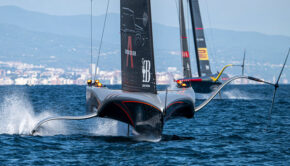
British lead toward 37th America’s Cup →

France: Last in, First out →

LVC37: Storms postpone first cut →
© 2024 Scuttlebutt Sailing News. Inbox Communications, Inc. All Rights Reserved. made by VSSL Agency .
- Privacy Statement
- Advertise With Us
Get Your Sailing News Fix!
Your download by email.
- Your Name...
- Your Email... *
- Name This field is for validation purposes and should be left unchanged.

- BOAT OF THE YEAR
- Newsletters
- Sailboat Reviews
- Boating Safety
- Sails and Rigging
- Maintenance
- Sailing Totem
- Sailor & Galley
- Living Aboard
- Destinations
- Gear & Electronics
- Charter Resources
- Ultimate Boating Giveaway

Hydrofoils for Sailboats
- By By Steven Callahan
- Updated: July 29, 2020
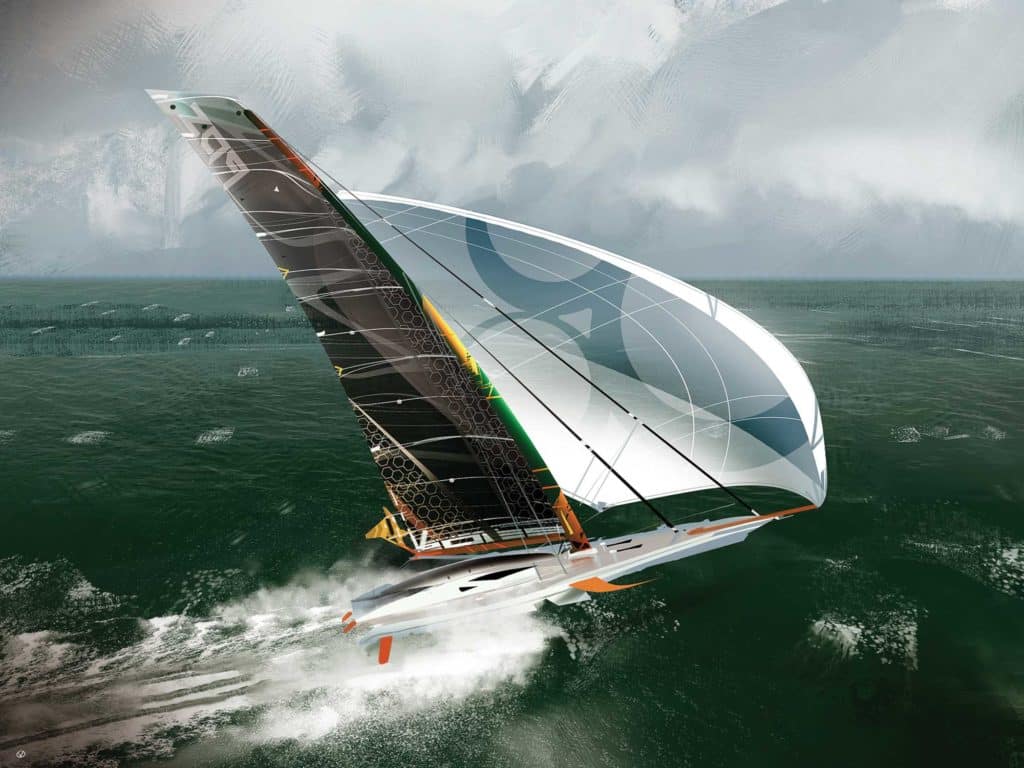
Hydrofoils have been providing dynamic lift since fish sprouted fins. And people have been employing foils ever since they first put paddle to water, and certainly since adding keels and rudders to boats. But the modern, flying America’s Cup boats, kiteboards, Moth dinghies, shorthanded offshore thoroughbreds—these are all playing in a new world in which the terms “hydrofoils” or “lifting foils” describe those oriented to raise a hull or hulls from the water. In these racing realms, if you ain’t got foils, you ain’t got nothin’.
Lifting foils that allow these boats to sometimes home in on three times the wind speed might appear to be of little interest to cruising sailors, but with such common cruising features as self-steering and autopilots, self-tailing winches, rope clutches, fin keels and faster hull shapes all having been passed down from the racing scene, one must ask, “What promise, if any, do hydrofoils hold?”
Lifted or partially lifted boat patents extend back to 1869, but workable watercraft took roots along with early flight. Italian Enrico Forlanini began experimenting with foils in 1898. In 1906, his 1-ton 60 hp foiler reached 42.5 mph. Alexander Graham Bell’s HD-4 Hydrodrome flew on Bras d’ Or Lake at 70 mph in 1919. And several sailing foiler patents began appearing in the 1950s. Notably, JG Baker’s 26-foot monohull, Monitor, flew at 30-plus mph in 1955. Baker experimented with a number of foil configurations, and at least built, if not used, the first wing mast. The first offshore foiler was likely David Keiper’s flying trimaran, Williwaw , in which he crisscrossed the Pacific in the 1960s.
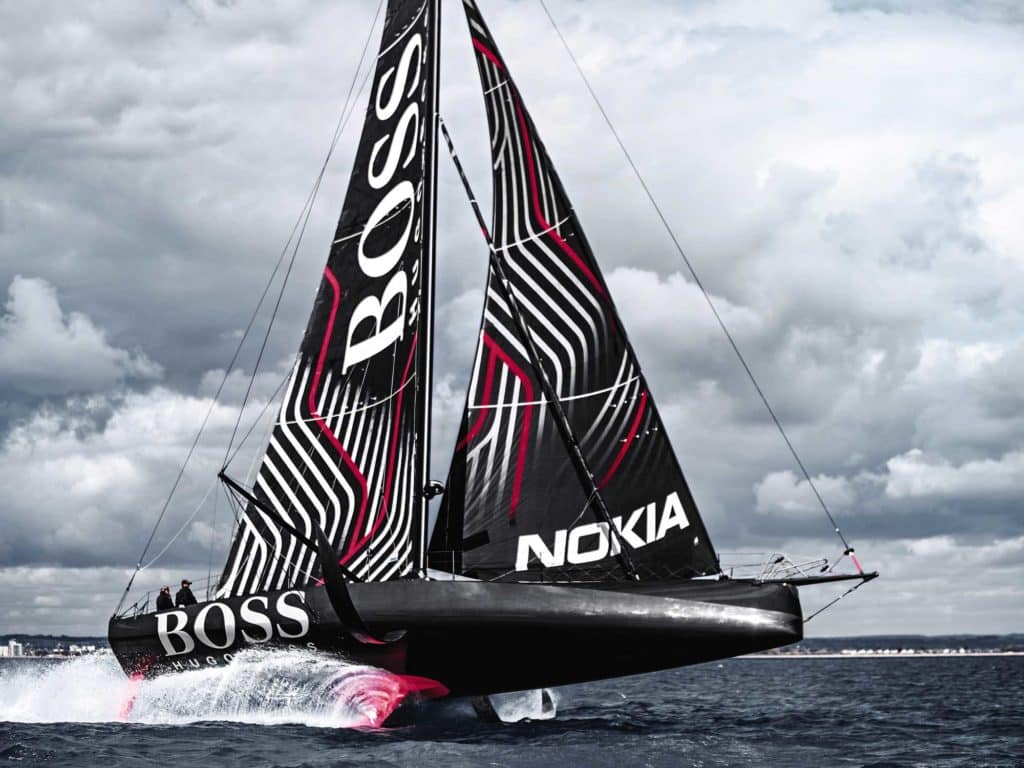
By the 1980s, numerous speed-trial and foil-enhanced offshore-racing multihulls showed huge promise, and have since evolved into behemoth trimarans clocking 30 to 40 knots continuously for long periods, not to mention the monohulls in the Vendée Globe (and soon the Ocean Race) that are capable of speeds exceeding 30 knots. But as boat designer Rodger Martin once reminded me, “If you want a new idea, look in an old book.” He was right. The fully foiling monohulls that will compete in the 2021 America’s Cup will bring things back full circle to the foiling monohull Monitor .
Fluid Dynamics Primer
Any foil—a wing, sail, keel, rudder or lifting foil—redirects the flow of fluid (air included), creating high- and low-pressure areas on opposite sides of the appendage, while developing lift perpendicular to the foil’s surface.
Advancements in foiling science is due in part to the hundreds of foil shapes that were tested, with tabulated results, by the National Advisory Committee for Aeronautics, the forerunner of the National Aeronautics and Space Administration. For the better part of a century now, aircraft and boat designers have been able to choose from a spectrum of refined foil sections that produce predictable amounts of lift and drag for known speeds of fluid and angles of attack, or the angle at which the foil passes through the fluid. Sections of efficient faster foils, as seen on jets or as we flatten our sails to go upwind or reach high speeds, have smaller nose radii and are thinner, with the thickest section of the foils farther aft, up to nearly halfway toward the trailing edge.
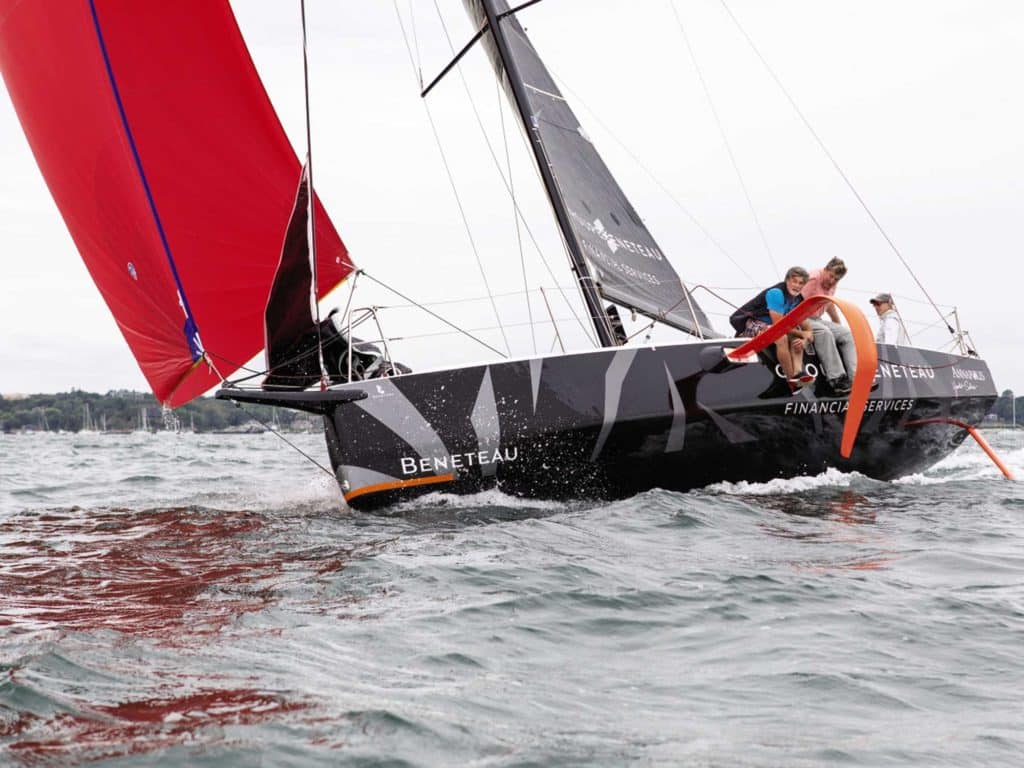
The most efficient foil sections at slow speeds are fatter, with the maximum thickness farther forward, and with larger nose radii, than faster foils. The angle to fluid flow or angle of attack also is greater. We see these slower foils on wings of prop planes and sails when off the wind or in light conditions.
Most sailors are familiar with traditional foils on boats, the teardrop sections of keels that produce lift to weather, reducing leeway, and of rudders, allowing them to steer. Even a flat plate can be a foil, but these tend to be inefficient. Such a shape is prone to fluid separation from the surface, meaning they stall easily, and they maintain poor lift-to-drag ratios. Even keels and rudders are somewhat lift-compromised because they are symmetrical and have to work with fluid coming from either side, whereas lifting foils are more like aircraft wings or propellers, with asymmetrical sections honed for performance in a more stable, fluid flow.
The point is, any foil can be employed at various angles to the surface to prevent leeway, produce increased stability, or help lift the boat out of the water. But those not required to work with fluid flowing from opposite sides can then be honed to maximize lift and minimize drag. Asymmetrical foils were used on boats like Bruce King’s bilgeboarders, including Hawkeye , back in the 1970s. And, designers, including Olin Stephens, had previously employed trim tabs behind keels to improve keel performance.
Sails, which are heeled airfoils, not only drive the boat forward, but they also produce downforce, actually increasing the dynamic displacement of the boat. To counter this and keep the boat sailing more upright, multihull designer Dick Newick first employed slanted asymmetrical hydrofoils in the outer hulls of his small charter trimaran, Lark , in 1962. A portion of the lift developed by the hydrofoil resisted leeway, while a portion worked to actually lift the leeward hull, keeping the boat more upright and reducing dynamic displacement and drag.
Anyone who has ridden on even a foil-stabilized boat will know how riding at least lightly on the waves, and especially above them, beats smashing through them. When boats lift off, everything gets a lot smoother, drag falls away, and the boat accelerates.
Cruising on Foils
But why would a cruiser want to whip over the sea? Wouldn’t this demand an inordinate amount of attention by the crew? Would lifting foils even be applicable to a boat that must have substantial displacement to carry crew and stores? Aren’t cruising-boat hydrofoils an oxymoron?
Maybe, but I believe our boats’ hulls are likely to sprout fins much as fish have as we orient foils to more efficiently resist leeway, add stability, aid steering, reduce drag, increase comfort, allow for shallower draft, and enhance wider variations in hull shapes.
Boats have gotten increasingly wide through the years to advance form stability, improve performance (primarily off the wind), and boost interior volume. But the downside is that fat boats tend to slam more upwind. What if you could reduce dynamic displacement of the boat and lift that hull even partially from the water? The result would be less slamming, especially upwind.
At the same time, what about narrower boats that are known for being more seakindly, especially when closehauled, but lack form stability to carry adequate sail area for powering upwind, and tend to roll badly downwind? Or shallow-draft vessels that are lovely for cruising, but again, tend to suffer from reduced stability? Foils can give that stability back.
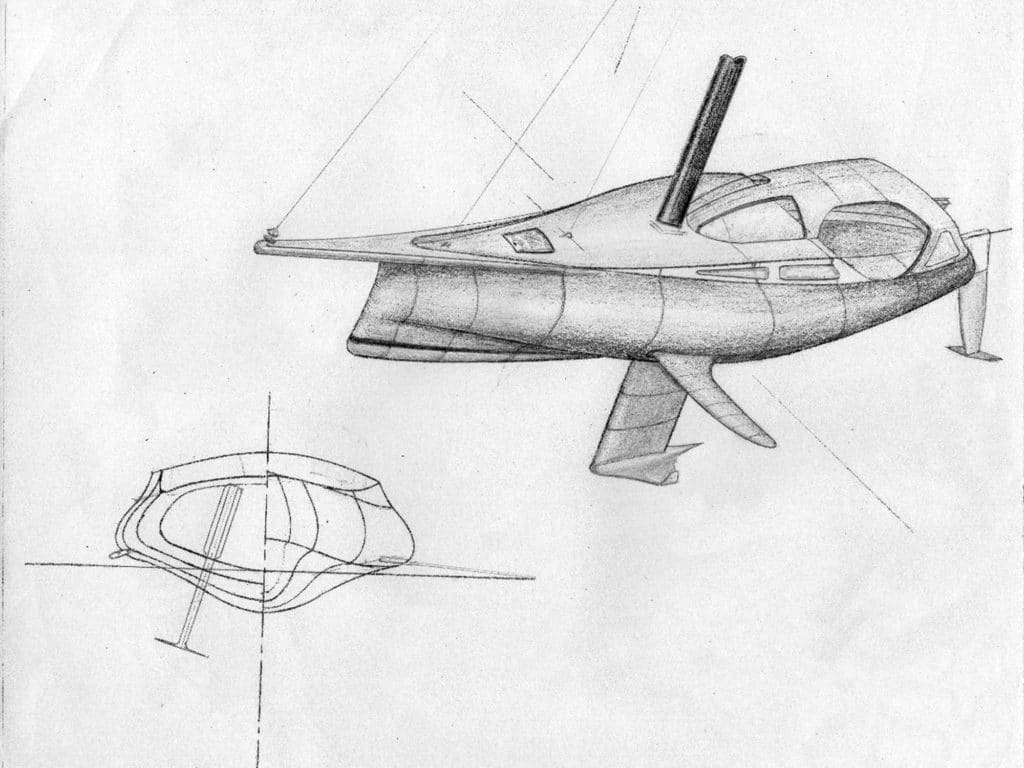
Looking ahead, boat designers might choose to reduce ballast, making up for it with a foil. In short, lifting foils can reduce boat drag and motion while increasing power and performance.
Pitching also does no favors for speed or crew comfort. Foils can come into play here as well. Foils parallel to the sea’s surface resist motion up and down, and a lifted boat skating above chop also is less prone to hobby-horsing through waves. Multihulls have always been particularly susceptible to pitching for a number of reasons, but watching videos of multihulls sailing to weather show an obvious huge advantage that foilers have compared with nonfoilers. Offshore multihulls now routinely employ T-foils on the rudders to control the fore and aft angles of the boat (attitude), a feature easily adaptable to any vessel.
OK, so what’s the cost? Obviously, the more things sticking through the hull, especially if they are retractable, the more it’s going to impact the interior. There would be added weight, complexity and cost. Foils also create noise, and there’s susceptibility to damage from hitting stuff. And let’s not forget compromises with shapes, purposes and things not yet imagined.
As for damage, it’s possible to fold the foils back into the hull. Think swinging center- boards or actual fish fins. Daggerboardlike foils can at least employ shock-absorbing systems similar to the daggerboard arrangements found in many multihulls. This includes weak links that are outside the hull, so if a foil is struck, it frees the foil to fold back or to come off before being destroyed or damaging the hull. Or, foils might hang from the deck rather than penetrating the hull, allowing them to kick up (and to be retrofitted to existing boats). These configurations also relieve the interior of intrusions, and keep the noise more removed from it. I have no doubt that numerous talented designers will be exploring all kinds of options and compromises in coming years, finding ways to make foils both practical and more than worth the compromises.
Sailing more upright, shallower draft, speed, comfort—what’s not to like? Just what is possible? I have a feeling the cruising community is about to find out.
Steven Callahan is a multihull aficionado, boat designer and the author of Adrift , an account of his 76 days spent in a life raft across the Atlantic.
- More: foils , How To , hydrofoils , print june july 2020 , sailboat design
- More How To

Grease the Wheels of Your Boat: A Guide to Proper Lubrication

A Bowsprit Reborn: A DIY Renovation Story

Rigging Redo: Our Switch to Synthetic

Top Tools for Sailboat Cruising: Must-Have Gear for 2024

Galápagos: A Paradise Worth the Paperwork

Around Alone

- Digital Edition
- Customer Service
- Privacy Policy
- Terms of Use
- Email Newsletters
- Cruising World
- Sailing World
- Salt Water Sportsman
- Sport Fishing
- Wakeboarding
ACTIVE STORM TRACKER Hurricane and Tropical Storm Information Learn more

Service Locator
- Angler Endorsement
- Boat Towing Coverage
- Mechanical Breakdown
- Insurance Requirements in Mexico
- Agreed Hull Value
- Actual Cash Value
- Liability Only
- Insurance Payment Options
- Claims Information
- Towing Service Agreement
- Membership Plans
- Boat Show Tickets
- BoatUS Boats For Sale
- Membership Payment Options
- Consumer Affairs
- Boat Documentation Requirements
- Installation Instructions
- Shipping & Handling Information
- Contact Boat Lettering
- End User Agreement
- Frequently Asked Questions
- Vessel Documentation
- BoatUS Foundation
- Government Affairs
- Powercruisers
- Buying & Selling Advice
- Maintenance
- Tow Vehicles
- Make & Create
- Makeovers & Refitting
- Accessories
- Electronics
- Skills, Tips, Tools
- Spring Preparation
- Winterization
- Boaters’ Rights
- Environment & Clean Water
- Boat Safety
- Navigational Hazards
- Personal Safety
- Batteries & Onboard Power
- Motors, Engines, Propulsion
- Books & Movies
- Cockpit Confessions
- Communication & Etiquette
- Contests & Sweepstakes
- Colleges & Tech Schools
- Food, Drink, Entertainment
- New To Boating
- Travel & Destinations
- Watersports
- Anchors & Anchoring
- Boat Handling
- ← Technology
Hydrofoils: Boats That Fly
Advertisement
Hydrofoils make everything from water skis to sailboats to giant ferries faster (much faster). But how the heck do they work?
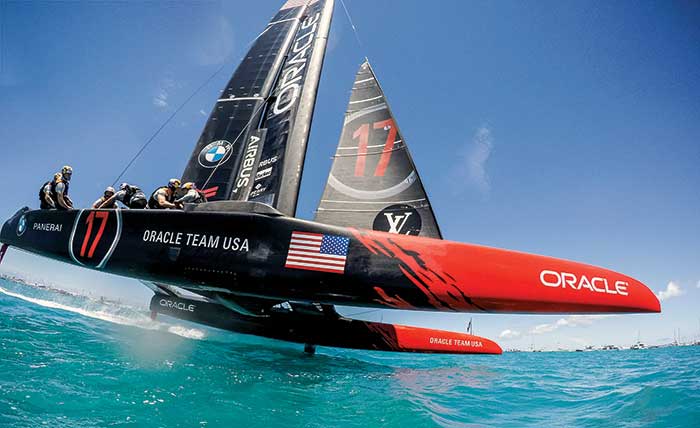
Oracle Team USA's AC50 "flying" at nearly 50 mph. (Photo: Ricardo Pinto)
Ever wonder why a sleek, powerful recreational boat is not even as fast as a typical economy car? It has to do with friction. An economy car needs a little over 100 horsepower to speed by at 100 mph, but pushing a boat through the water that fast takes several hundred horsepower. The reason is that water is almost 800 times denser than air.
Imagine standing on your dock in a 10-knot wind — it's not hard to do. Now imagine being in a river trying to stand up to a 10-knot current. The water is so much denser that no matter how strong you are, you'd be swept away. A boat hull has to push through all that dense water while a car can slip through the air much easier.
Planing boats are able to go faster than displacement boats because they lift part of their hull out of the water as they race over their bow wave, but there's still a lot of friction from the water on the rest of the hull. If you could get the hull all the way out of the water, you'd eliminate that friction, and the boat could go faster with the same amount of power.
The Science
Most of us have a pretty good understanding of how an airplane flies. As air flows over and under the wings (also called airfoils), it creates lift. Once an airplane is going fast enough, the lift that the wings create allow it to rise above the earth.
If you were to mount a wing or two (called hydrofoils) under a boat, all that dense water can be put to good use by pushing the boat's hull out of the water. Then friction only acts on the small foils, not on the whole hull, which is why a 130-foot hydrofoiling sailboat can "fly" at over 50 knots. Powerboats have added friction from the propulsion system that has to remain in the water, but even then, large hydrofoiling ferries can exceed 45 knots.
Speed is not the only advantage that hydrofoils give boats. Because the hull is out of the water, all the energy from waves that would normally pound against the boat pass harmlessly underneath it, creating an eerily smooth ride. Even so, hydrofoiling is typically best in somewhat protected waters.
Don't look for hydrofoils on your next runabout anytime soon because they're much more difficult to engineer and typically triple the cost of a boat. The good news is that there are other ways to 'foil that are affordable — see "Experience Hydrofoiling For Yourself" at below.
Experience Hydrofoiling For Yourself
Hydrofoil kiteboards.
If you've even seen a kiteboard zooming in a strong breeze, you know they're plenty fast. Add a hydrofoil, and suddenly you add a new dimension. These boards take lots of skill and practice to master, but the ride is said to be much smoother and even faster than a conventional kiteboard. Cost starts at around $1,000.
Hydrofoil Waterskis
These single-ski hydrofoils are really a sit-on-ski, and once you've mastered the technique, the foils will lift you up and you'll be "flying." Unlike conventional skis, these aren't designed for speed, and 18 mph is where they typically "liftoff' and suggested top speed is about 25 mph. It's also important not to ski in shallow water due to the depth of the foils. Cost is typically $1,500 and up.
Hydrofoil Windsurfers
Not content to take a surfboard and add a sail, windsurfers developed foils that allow the board to "levitate." The biggest advantage is the smoothness of the ride — a real benefit because these rigs usually sail in very strong winds with plenty of chop. Cost is about $2,500 to get started.
Hydrofoiling Small Sailboats
You don't have to spend millions on a boat like the America's Cup racers if you want to hydrofoil. The Waszp costs about $10,000, though even for dinghy racers, there's a learning curve to get these boats on their foils, with speeds up to 27 mph.
Note that most companies suggest wearing a helmet when using foiling products because of the speeds achievable and the hard, sharp foils these devices have.
Foiling The Competition
America's Cup boats are often what people think of when they hear the word "hydrofoil." Hal Youngren, an aeronautical engineer and one of the designers for the 2013 and 2017 America's Cup racers, says the difference in speed that foils make is impressive. The fastest nonfoiling catamarans in previous races could barely reach 35 knots, while the 2017 foiling cats hit 50 knots. Youngren says that these 50-foot cats are able to lift their hulls completely out of the water using only about three-quarters of a square meter of foil area (about the size of a medium-sized TV). Below about 15 knots, he says, the boats sail much like a nonfoiling boat with hulls in the water, but once over that speed, the boats start to "fly" and their speed dramatically increases.
The America's Cup Class AC75 Boat Concept Revealed
An exciting new era in America's Cup racing was unveiled in November 2017 as the concept for the AC75, the class of boat to be sailed in the 36th America's Cup is released illustrating a bold and modern vision for high performance fully foiling monohull racing yachts.
The America's Cup AC75 Boat Concept Revealed
The Emirates Team New Zealand and Luna Rossa design teams spent the previous four months evaluating a wide range of monohull concepts. Their goals have been to design a class that will be challenging and demanding to sail, rewarding the top level of skill for the crews; this concept could become the future of racing and even cruising monohulls beyond the America's Cup.
The AC75 combines extremely high-performance sailing and great match racing with the safety of a boat that can right itself in the event of a capsize. The groundbreaking concept is achieved through the use of twin canting T-foils, ballasted to provide righting-moment when sailing, and roll stability at low speed.
An underlying principle has been to provide affordable and sustainable technology "trickle down" to other sailing classes and yachts. While recent America's Cup multihulls have benefitted from the power and control of rigid wing sails, there has been no transfer of this technology to the rigs of other sailing classes. In tandem with the innovations of the foiling system, Emirates Team New Zealand and Luna Rossa are investigating a number of possible innovations for the AC75's rig, with the requirement that the rig need not be craned in and out each day. This research work is ongoing as different concepts are evaluated, and details will be released with the AC75 Class Rule before March 31, 2018.
The America's Cup is a match race and creating a class that will provide challenging match racing has been the goal from the start. The AC75 will foil-tack and foil-gybe with only small maneuvering losses, and given the speed and the ease at which the boats can turn the classic pre-starts of the America's Cup are set to make an exciting comeback. Sail handling will also become important, with cross-overs to code zero sails in light wind conditions.
A huge number of ideas have been considered in the quest to define a class that will be extremely exciting to sail and provide great match racing, but the final decision was an easy one: the concept being announced was a clear winner, and both teams are eager to be introducing the AC75 for the 36th America's Cup in 2021. — AmericasCup.com
Related Articles
The truth about ceramic coatings for boats.
Our editor investigates the marketing claims of consumer-grade ceramic coatings.
Fine-Tune Your Side Scan Fishfinder
Take your side-scanning fishfinder off auto mode, and you’ll be spotting your prey from afar in no time
DIY Boat Foam Decking
Closed-cell foam flooring helps make boating more comfortable. Here’s how to install it on your vessel
Click to explore related articles
Charles Fort
Contributing Editor, BoatUS Magazine
Charles Fort is BoatUS Magazine's West Coast Editor. He often writes local news items for BoatUS Magazine's Waypoints column and contributes to Reports, in-depth tech features in every issue written to help readers avoid accidental damage to their boats. He is a member of the National Association of Marine Surveyors, he's on ABYC tech committees, and has a 100-ton U.S. Coast Guard license. He lives in California.
BoatUS Magazine Is A Benefit Of BoatUS Membership
Membership Benefits Include:
Subscription to the print version of BoatUS Magazine
4% back on purchases from West Marine stores or online at WestMarine.com
Discounts on fuel, transient slips, repairs and more at over 1,200 businesses
Deals on cruises, charters, car rentals, hotel stays and more…
All for only $25/year!
We use cookies to enhance your visit to our website and to improve your experience. By continuing to use our website, you’re agreeing to our cookie policy.

- FlySafe ® Foil Control
- iFLY Reviews
- Our Partners
- Distributors
Class Association
Enter your keyword.
Just enjoy high speed - foiling
” iFLY – Born to FLY “
Just enjoy foiling, ” high performance sailing “, ” we love speed “, ” join the adventure “.

iFLY15 – Technical SPECS
Length 4.63 m, 15 ft..
A Foiling Catamaran for 1-2 person(s) does not need to be any longer than this. The ancient rule that says you need length to achieve speed does not apply, as hulls do not touch the water at most times.
Width 2.50 m.
This width provides plenty of righting moment, still being road legal ato be transported in horizontal position without disassembly.
7.5 m mast / 11.2 sqm mainsail
7.5 m mast with 11.2 sqm deck-sweeper mainsail. – 8.5 m mast on iFLY RAZZOR Pro with bigger rig
Draft: 95 cm
Weight: 90 kg.
90 kg ready to sail. A very light boat, providing nonetheless excellent stability for everyday suitability.
Crew 1-2 - max.180kg
Flysafe® foil control.
T-Foils Main Foils and Rudders FlySafe automatic dynamic foil control Additional Option: Main Foil Differential >>>
Know More >>>
Different - Rig Options
LATEST DEVELOPMENT OF “DECK SWEEPING” MAINSAIL THE ROLLABLE HERU WING RIG LIGHT WIND FORESAIL «CodeF»
Full Carbon Hulls
Looking for the perfect setup for your foiling sailboat.
We can recommend the best iFLY setup and accessories for your boat. Get in touch for the ultimate sailing experience!
Performance
A great number of innovations all over the catamaran and the perfect match of all components allow controlled high-speed foiling experience. iFLY15 is full of innovations, e.g. in hull design, hydrofoils, rudders, automatic flight control system, two-layer wing trampoline, high performance rig…
HULL Design
full carbon – lightweight – performance design: Born to foil
High Performance Rig Options
LATEST DEVELOPMENT OF “DECK SWEEPING” MAINSAIL WORLD PREMIERE: THE ROLLABLE HERU WING RIG : WORLD PREMIERE: LIGHT WIND FORESAIL «CodeF». ALLOWS UPWIND FOILING (as well as other courses/points) ALREADY IN EXTREMELY LIGHT BREEZE. Know More >>>
Two Layer Trampoline
AERODYNAMIC INNOVATIVE WING TRAMPOLINE CREATING LIFT.
Full Carbon T-Foils
SCIENTIFICALLY DEVELOPED high-end foils for early take off, high speed and maximum stability.
flySafe® dynamic foil control system
The foils are controlled independently, dynamically and precisely on both sides by the flySafe® foil control system . This enables high performance sailing through stable flight. The unique foil control system of IFLY15 is a 7 years proven system developed by CEC Catamarans. Know More >>>
IFLY MAIN FOIL DIFFERENTIAL TECHNOLOGY
MDT FOIL CONTROL – iFLY rake control The sophisticated main foil differential is an active flight assistance – The Rake is adjustable while sailing. Advanced Rake Control is for the experienced, performance-oriented Catamaran sailors / pro sailors and is a feature on the iFLY RAZZOR Pro. Know More >>>
Innovations and more >>>
In the hand of the experienced sailor, iFLY15 is a high-performance racing machine. STABILITY IS NOT CONTRADICTORY TO HIGH PERFORMANCE OR SPORTINESS , on the contrary, it is a prerequisite for safe reaching and maintaining constant high speeds. Stable flight allows the sailor to concentrate on the course, on the wind, as well as on opponents and strategy – rather than permanently getting distracted by working on the foiling balance.
EARLY TAKE OFF IN WINDS AS LOW AS 2Bft. / 6 KNOTS , by combining the innovative “KickOff” foil control with a trampoline that provides boost and with the latest generation of rig and foils.
BOAT SPEEDS FAR BEYOND DOUBLE WIND SPEED CAN BE ACHIEVED . Enjoy high speed foiling with top speeds far beyond 25 knots – in ideal conditions up to 30 knots.
CONTROLLED FOILING EVEN IN THE UPPER WIND RANGE BEYOND 22KNOTS OF WIND SPEED – supported by the new FlySafe® Automatic Foil System.
FOILING PLEASURE AND PERFORMANCE ALSO IN CHOPPY WATERS
FREEDOM ! FLYING SOLO OR OPTIONAL WITH CREW . You have the choice. No manhunt for crew. But still enjoy the opportunity of taking a friend or family to fly with you. Up to 140kg of crew weight. (To keep the boat and especially the mast light, we specified the iFLY15 components intentionally not for double trapeze.)
NO HOISTING AND LOWERING OF DAGGERBOARDS while sailing. (Only for beaching or in shallow waters.)
FREEDOM TO SWITCH BETWEEN FLYING MODE OR SAILING AS A CONVENTIONAL CATAMARAN (with at least the leeward hull touching the water). Within seconds iFLY15 can be switched to Non-Flight mode, even while sailing. In that mode, iFLY15 will not take off, but the foils will still create lift and give an extra agile sailing behavior, which is on the same time very stable as rudder Foils will avoid pitch poling. Non-Flight mode is providing additional security in extreme high wind speeds. It is also useful for less experienced sailors or in all situations, where taking off is undesirable (e.g. in the harbor or while towing…).
EASY TO LEARN FLYING BY AVERAGE SKILLED AND TRAINED SAILORS
EASY BEACHING AND SLIPPING , as simple as with any conventional beach catamaran by using a standard catamaran beach trolley. Foils remain flat under the keel, with the daggerboard lifted as on a conventional catamaran.
SIMPLE TO DISASSEMBLE PLATFORM . Width of 2.50m is also road legal in most countries for horizontal transport without disassembly.
DAGGERBOARDS CAN BE PLUGGED IN FROM ABOVE and Foils securely anchored from below with one central screw.
FAST SET-UP OF THE iFLY15 FROM ROAD TRAILER TO SAILING . Simple rigging the mast, no genacker boom, no foresail, no spi.
SILENT AND CALM PLANING ABOVE THE WAVES . Flight height of up to 90cm, avoiding even high waves below.
EASY TO FOIL THE JIBE (without landing). Stable maneuvers are made easier by the fact that the four T-Foils always remain in the water.
« INTERNATIONAL FORMULA 15 FOIL » Class Association. The new development class for FOILING, SINGLE HANDED on MULTIHULLS. Multi manufacturer class in the tradition of a Formula18, A-Class or international Moth. Enables large regatta fields and evolution of the boats, following the technical progress (which is especially essential in the case in Foiling). Strict regulations to avoid uncontrolled exaggerated development.
Contact : [email protected]
Catamaran Europe Central
The iflysail team, is looking forward to your message, more to know about ifly foiling , interesting tech, high performance rig options >>>, flysafe® dynamic foil control system >>>, ifly main foil differential technology >>>.
MDT FOIL CONTROL – iFLY rake control
News and More
Ifly foiling experience >>>, press articles >>>, events >>>.
High-Performance Foils
Shaping better centerboards and rudders
From Issue July 2020
W hile it’s generally accepted that the right sails and sail trim will determine how close you can sail to the apparent wind, a sailboat’s progress to windward also depends on the lift and drag generated by the centerboard and rudder. How much difference does proper foil shape make over a simple rounded leading edge and tapered trailing edge, anyway? Foils operating in fluids, whether air or water, are a well-studied topic. C.A. Marchaj, in his book, Sailing Theory and Practice , discusses the theory and gives the results of actual tests of differences in foil planform (side view), cross-section shape, size, and aspect ratio (AR – length to width). Lacking other constraints, an ideal centerboard, daggerboard, or rudder blade should have a reasonably high AR (greater than 2) planform with a streamlined cross-section that has a parabolic leading edge and a thickness of somewhere near 10 percent of the chord width (the distance from leading edge to trailing edge). A thickness of 8 percent produces less drag but stalls sooner; 12 percent has a higher stall angle but produces more drag.
Exactly where the point of maximum thickness should be located is a matter of some debate. Marchaj suggests it should be at 50 percent of the chord width, halfway between the leading edge and trailing edge, but provides no data to back that up. Other sources suggest that the NACA (National Advisory Committee on Aeronautics) symmetric foil sections, originally developed during aircraft research, are actually a good fit for boat foils operating at low speeds in water. A NACA 0010 foil, for example, has a maximum thickness of 10 percent of the width of the foil, located at 30 percent from the leading edge.
Of course, there are many practical reasons why not all keels, centerboards, and rudders have high AR planforms, but the cross section for a foil of any planform should be streamlined. My personal experience of doing it wrong on one boat, and getting it right on another boat, has convinced me that the NACA sections and guidelines above provide good performance.
HORNPIPE, my first sail-and-oar boat, was an 18’ Kurylko Alaska with a standing-lug ketch rig, and sailed well enough to windward in flat water, but lost 10 to 15 degrees of pointing ability as soon as the water got choppy. I knew it wasn’t poor sail trim. Eventually I got looking at the daggerboard and analyzed it. It was only about 2.5 percent of the sail area and its thickness was only about 6 percent of the chord width, neither big enough or thick enough in my view, and in rough water it lost laminar flow and lift. When I designed my 18′ lug-yawl cruiser, FIRE-DRAKE, I gave it a thicker centerboard with a greater fraction of the sail area, about 4 percent. I also gave it a straight quarter chord line (think of the shape of the wing of a Spitfire aircraft) and a moderately high aspect ratio of about 3:1 for the planform area. To get the daggerboard foil shaped accurately and quickly I opted to have it cut on a computer numerical control (CNC) machine. All that was left for me to do was sand, seal and paint, and make an epoxy-lined hole for the pivot pin.
The results have been what I had hoped for. FIRE-DRAKE sails quite well to windward and maintains its performance in rough water. I sailed in the company of a similar boat—with the same length and beam, the same weight, and the same sail plan—along the south half of the Inside Passage, and that boat’s centerboard was shaped by eye. When sailing to windward, FIRE-DRAKE would consistently point higher and walk away in speed. My centerboard even let me continue sailing to windward when my partner gave up and took to the oars.
Although I had the daggerboard shaped with a CNC router, it is possible to shape a high aspect ratio, fully streamlined foil in the home shop. I’ll walk you through my second project, a kick-up rudder blade that I made at home to replace the original one I built for FIRE-DRAKE. I settled on a planform that is one-quarter of an ellipse with an elliptical leading edge and a straight trailing edge. (The shape would move the center of lateral resistance of the boat aft a few inches, and is intended to lighten the weather helm I’d experienced with the original rubber blade.) I drew the new blade with an aspect ratio of 2.5:1, with a length of 30″ (762 mm) and a maximum chord width of 12″ (305 mm), which would increase the lift and reduce the tip vortex drag.
To draw the planform shape of the quarter ellipse you can use an online graphing tool such as Desmos for a full ellipse. If you center the ellipse at zero, you can drag the two axes out until you get the aspect ratio you want. Since the graph has a grid in the background, you can then print out a screen capture of a quarter of the resulting ellipse and scale up the printed image to the actual dimensions required. If you are comfortable with computers, you can download and run Freeship (available for Windows only) which has a “keel and rudder wizard” that accurately generates several different planforms.
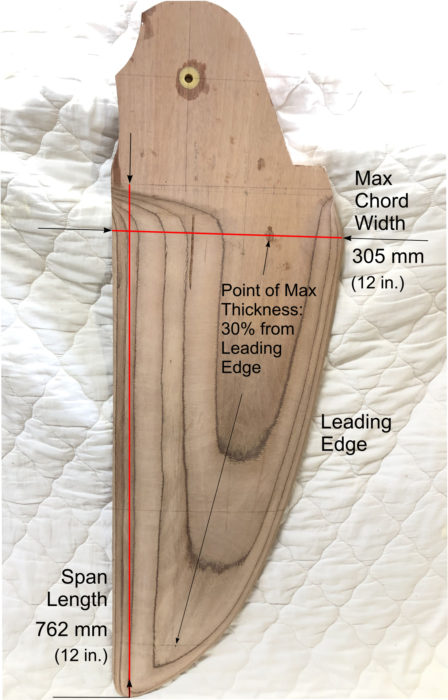
The new rudder blade for FIRE-DRAKE has a quarter-ellipse planform. The plywood’s glue lines show the contours that help with shaping the foil.
Obtaining the cross-section profile of a chord of a given width is best left to a computer. For any of the NACA foils, like the 0010 foil I mentioned above, Competition Composites Inc . (CCI) has a very simple and handy calculator . You need enter only the chord width and the maximum thickness and it will generate a table of X-Y coordinates that you can copy and print out. They’ll be your offsets for drawing a pattern for the foil cross-section. If you intend to sheathe your foil with ’glass and epoxy, for example, you can also enter the skin thickness and it will calculate the coordinates for the plywood core.
Now, here’s the tricky bit. If you have a rectangular foil planform, you only have one chord width and therefore one section profile for the entire length of the foil. However, if you have any other planform (e.g., half-ellipse, quarter-ellipse, trapezoidal, straight-chord-quarter-line, etc.), the thickness, which will be one-tenth of the chord width, changes along the length of the foil because the chord width changes.
I used the CCI calculator to generate profile coordinates for three different points along the length of the rudder blade: at the root, at about two-thirds of the way along and at about 90 percent of the way to the end. I chose those points because the chord width for my quarter ellipse planform doesn’t change much for the first half of its length, but it changes more quickly toward the tip. The idea is to shape the foil to these profiles at these points and then taper the foil evenly between them. You can lay out your foil plan directly on to the ply or you can use something thin, like doorskin, to make and fine-tune a template, which is what I did.
I made a blank for my rudder by gluing layers of marine ply with epoxy to the required 1″ thickness. I have found that the plywood, in spite of its cross-grain plies, has sufficient strength for the size of small-boat foils that I have built (though the cross-grain would weaken a long thin foil). Plywood does not warp and has the added advantage over solid wood in that the plies create a kind of contour map that give you graphic visual feedback as to the evenness of your surface once you start shaping the foil. You can make a foil with solid wood or even foam plus a ’glass-and-epoxy skin, but without the plywood laminates as guides, you would have to make more section profile templates to ensure a smooth and accurate shape.
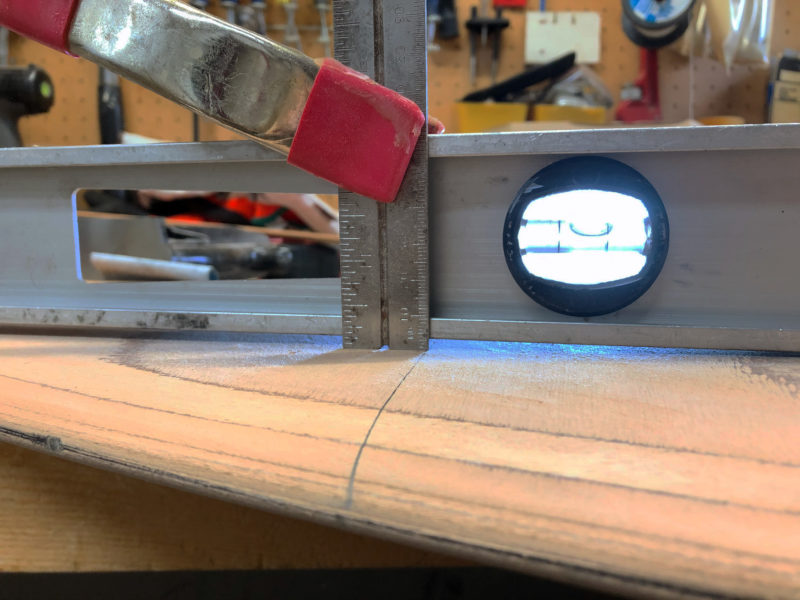
Clamping a 4′ level to the flat part of the rudder blade provides a reference line to gauge how much wood to remove to achieve the foil’s taper.
The next step is to taper the thickness of the laminated foil blank along its full length. Knowing the required thickness at your chosen points, you can draw a pattern for the curve of the taper and half the thickness of the blade stock and measure how much wood you have to remove at each point. I clamped my 4′ aluminum I-beam level to the flat part of the rudder blade above the shaped part, and used a ruler to measure the depth I had to cut to. To remove the wood for this part of the project, I used my #4 Stanley plane. While I have a power hand planer, I didn’t trust myself with it to not take too much off too quickly.
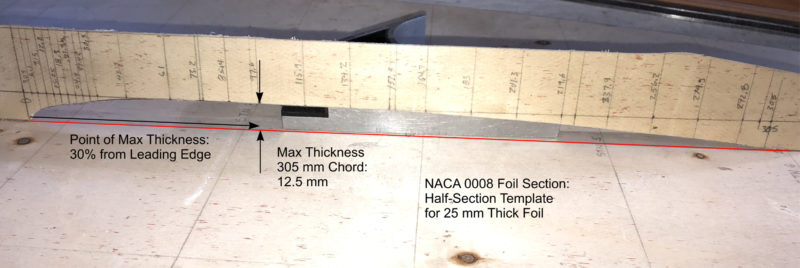
The female half-section template for a given chord for a foil gets its shape from the X-Y coordinates generated by a foil calculator.
I made three female half-section profile templates, one for each of the three points noted above, by plotting out the generated X-Y coordinates on pieces of doorskin and carefully cutting them out. One thing to note is that the CCI calculator generates a profile that has a trailing edge of zero thickness. Obviously, this is not practical to build in wood, and a knife edge is not that critical anyway. I adjusted the trailing edges so that the finished edge would end up about 1/3″ (4mm) thick.
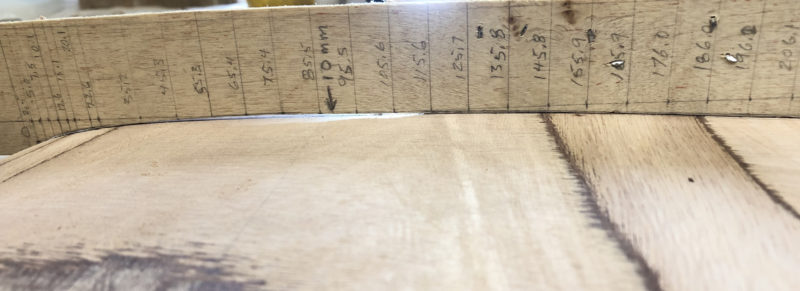
Applying the template to the foil in the works shows the high and low spots as the shaping continues.
Next, I used the profile templates to shape the foil at my three chosen points. I shaped the plywood with a Shinto rasp , regular rasps, and coarse sandpaper. It’s a process of taking some wood off, placing the template, and repeating until you get the section of wood shaped to the templates. Once that is done, I could go to work taking down the wood between the sections, using the ply layers as a guide. I used my block plane, Shinto rasp, and sandpaper for this task. I eyeballed a smooth transition around the tip from the leading edge to the trailing edge.
I sealed the surface of the shaped foil with a couple of coats of epoxy to provide a smooth, hard surface to accept a finish coat of marine epoxy enamel.
Alex Zimmerman is a semi-retired mechanical technologist and former executive. His first boat was an abandoned Chestnut canoe that he fixed up as a teenager and paddled on the waterways of eastern Manitoba and northwestern Ontario. He started his professional career as a maritime engineer in the Canadian Navy, and that triggered his interest in sailing. He didn’t get back into boatbuilding until he moved back to Vancouver Island in the ’90s, where he built a number of sea kayaks that he used to explore the coast. He built his first sail-and-oar boat in the early 2000s and completed his most recent one in 2016. He says he can stop building boats anytime. He is the author of the recently published book, Becoming Coastal .
For further reading on the pros and cons of the variables in foil design, Competition Composites (CCI) has a good discussion . For those of you who want to go into the math, Paul Zander has a good presentation from nearly 20 years ago, and also, for those inclined that way, an updated discussion with a lot more math.
You can share your tips and tricks of the trade with other Small Boats Magazine readers by sending us an email .
Share this article
Join The Conversation
We welcome your comments about this article. If you’d like to include a photo or a video with your comment, please email the file or link.
Comments (17)
Is there someone who can craft a good rudder for my boat? I have not the time or the skills to do such. Have a 15′ Delaware Ducker. Love the boat but the rudder is (I think) a disaster. Hardly brings the boat around and doesn’t help much to windward. Flat plywood barn door out of 3/8″ ply with no shape other than outline that barely gets 2″ – 3″ into the water. If it could be a kick-up so much the better. I do a lot of shallow, sand-bottom sailing. Thank you for any help.
I know about the ducker and a foil shaped rudder will help a lot. Some of the modern ones built in glass and cold molded have been fitted with modern dinghy rudders and foil shaped daggerboards. They tack more like a dinghy than like my traditional one where I have to sail it around like a larger boat.
Most any small boat builder in your area should be able to build you a rudder. Lines for a kick up would be a nuisance. I don’t bother with them on a larger boat, just use a pivot bolt with tension. Means I have to shove it down.
You might want to look at the system that Mike Storer has developed for his goat island skiff, a straight foil, easier to shape.
Alex has done a great idea showing us how to work these out using hand tools. We used to do it in my dinghy sailing days by drawing a 30 % line. Make a bunch of parabola templates and hack away. For really long narrow boards before the days of carbon we used to use 5/4 stair tread fir.
Interesting article. When I built my Oughtred JII Yawl eighteen years ago, I did some research on appropriate foil profiles for the centerboard and rudder. It’s a long time ago now, so I don’t remember the exact profiles I chose, but I do believe I picked NACA 0010 for the CB. I picked another profile for the rudder, one that had a steeper stall angle, on the theory that with typical weather helm the rudder meets the flow at a steeper angle than the CB. I really don’t know how valid my theory is. I have no experimental evidence to back it up. Any thoughts?
Andrew, that seems to make sense although I haven’t seen any research to back that up.
Hi Andrew, I remember seeing your beautiful JII; but did not ask about the foils! I wonder how NACA 0010 compares with my approximate foil shape, inspired mainly by guesswork. Are these profiles available? By the way, I do not like plywood foils; CBs break. Friends near here lost their fine old rebuilt Wayfarer; were in danger themselves, when they capsized and the plywood board broke. Too near a rugged lee shore. A class racing boat, by a particular builder – all their plywood centerboards broke.
Iain, I don’t know what your standard foil shape looks like, but a NACA 0010 has a maximum thickness of 10% of the chord distance, occurring at 30% of the distance back from the leading edge. Marchaj believes that the maximum thickness should occur at about 50% of the distance back from the leading edge. Other designers agree, I think. If I understand him correctly, John Welsford uses a foil section that is closer to 50% distance, but I am not sure what thickness of foils he favors or what the exact foil shape is. You can see the shape, and all the requisite numbers for extracting an X-Y plot to reproduce them, for a whole bunch of different foil types, on the Airfoil Tools site. As for plywood foils, I understand your concern. Half the plies are oriented in the wrong direction and don’t provide much in the way of resisting sideways bending moments. However, it has been my experience that this is not a major concern if the foil is thick enough and not too long. The centerboard foil on my latest boat, for example, is ply, but is nearly 2″ (50 mm) at maximum thickness. It’s got over 1,000 nautical miles in four years under the keel by now, including a couple of practice capsizes, with no issues so far.
I don’t know what a standard Wayfarer foil looks like. Is it long and thin?
Very interesting article. I am just in the process of building a Lillistone Flint and have no experience building or knowledge of foil design and performance. I calculated the various ratios and percentages. The AR as per the plans is 2.43, so that looks good. The thickness however is only 4% of chord width. Area of the dagger board is 3.5% of sail area, so probably OK there too. Lillistone does state in the plans that the board can be made thicker if preferred so I think I may do that as 4% is a pretty big departure from the 8 – 10% of the chord width suggested. Any comments? The Flint was featured in this mag a few issues ago.
David, both my experience and authorities who design for a living and/or who have tested these things would suggest that 4% is rather too thin for good lift. I suspect that you might find it works reasonably well in dead flat water but you would lose lift and pointing ability as the water gets more turbulent. If it was me, and I hadn’t yet built the foil and its case, I’d go for one that was at least 10% and maybe even 12%. The additional thickness would also be more robust should you need to stand on it to flip the boat over if you capsize.
Thanks so much for taking the time to reply, Alex. I have decided to use some salvaged King William (King Billy here in Tasmania) pine that was salvaged. I thicknessed it to clean it up a bit and reckon I will eventually get 20 – 22 mm out of it. I plan to laminate 10 pieces into a 304mm board. Hopefully I will get a good result.
Hi David, It highly depends where you sail and how you sail. I have one older (1975) 420er dinghy for fun and local competitions with foiled board and rudder. But then I have 21″ German Jollenkreuzer veteran from 1952 which has both from 1/4″ steel plate, and it works fine. I sail that for pleasure on lakes. It would definitely be more performant (and point better) with both foiled, but I’m surprised how well it performs in its nearly ’70s (comparing to modern GRP boats with foiled boards).
For your job, I would probably stick to the plans. The rudder in this case is more important and can be somehow easily modified (foil). The centerboard I would keep the same, not only to conform the centerboard box (which would need to be sized), but also the overall design. Finally the most important here is what is your building and designing experience, because the worst thing is when something is incorrectly designed and then improperly built (the simple rounded plywood then may work better).
Anyway, I’m also thankful for this article. It reminds me my childhood when I built airplane models and used exactly the same methods used here to create the wings (in much smaller scale).
Thanks for your thoughts. I am going for a thicker foil and risk it (see reply to Alex above). I am well aware of risks in departing from designer’s work but I don’t think I will go far wrong.
Do SUP fins follow the rules for centerboards?
I’m not a SUP guy myself, but my understanding is that the fins are there to assist in tracking. That is, they don’t need to provide lift the way a sailboat keel/CB going to windward does. The thing you would be aiming for in the case of SUP fins is having sufficient lateral area to provide that tracking ability, and then having it streamlined to reduce drag. I would imagine that thinner would be better, although you’d still want a streamlined foil section, as that would produce less drag than a flat plate. The leading edge of a flat plate tends to separate the flow from the sides of the plate, even if that edge is rounded, and separation produces turbulence and drag.
For twenty years, beginning in the early 1970’s, I raced a Lido 14. The boat was pre-owned, and had its original solid wood foils which were in pretty bad shape, and I decided to build new foils. After reading Marchaj’s book, and the Lido 14 Class Rules, I designed a new centerboard and rudder. The NACA-0009 section most closely fit the required class measurements, and I used that profile. I did alter the leading edge of the rudder, making it more rounded, to allow for the fact that the rudder angle of attack is variable, and is more likely to stall.
In fleet racing, and sailing close hauled, the results were astounding, with the boat seeming to sail slightly sideways, relative to other boats. I also began to pay particular attention to the condition of the foil surfaces, as Marchaj writes that the drag on underwater foils is many times greater than the drag on the hull surface. One time we were sailing in an area of submerged trees, and my centerboard lightly brushed a tree branch. I then noticed that the centerboard ‘hummed’ on port tack. Later, when I examined to board, there was a barely visible scratch.
I very much enjoyed the article on high-performance foils in the July 2020 issue of the Small Boat Magazine .
For twenty years, beginning in the early 1970’s, I raced a Lido 14. The boat was pre-owned, and had its original solid wood foils which were in pretty bad shape, and I decided to build new foils. After reading Marchaj’s book, and the Lido 14 Class Rules, I designed a new centerboard, and rudder. The NACA-0009 section most closely fit the required class measurements, and I used that profile. I did alter the leading edge of the rudder, making it more rounded, to allow for the fact that the rudder angle of attack is variable, and is more likely to stall.
In fleet racing, and sailing close hauled, the results were astounding, with the boat seeming to sail slightly sideways to windward, relative to other boats. The boat didn’t seem to point higher, when close hauled, it just didn’t make as much lee way. More benefit on the port tack, a little less on starboard. I did set the centerboard jibe angle to the maximum allowed by class rules. In all honesty, I was probably the only one in the fleet that had read Marchaj. It still took me five years to win the fleet championship. I also began to pay particular attention to the condition of the foil surfaces, as Marchaj writes that the drag on underwater foils is many times greater than the drag on the hull surface. One time we were sailing in an area of submerged trees, and my centerboard lightly brushed a tree branch. I then noticed that the centerboard ‘hummed’ on port tack. Later, when I examined to board, there was a barely visible scratch.
I am a new subscriber to Small Boat Magazine , and look forward to each issue. Keep up the good work.
Was just about to make the centerboard for my Oughted Caledonia Yawl. So I was happy to see this article. But was then disappointed when I calculated my centerboard area to be only 1.9 percent of my total sail area. I briefly thought gee I will make it a little bigger…but then realized the centerboard trunk is already complete and limits that. I don’t plan on racing, so it is what it is.
Mark, I’d be really interested in your results once you launch the boat and do some trials. Theory is one thing, but nothing beats data from real-world results.
Leave a Reply Cancel reply
Your email address will not be published. Required fields are marked *
Stay On Course
More From This Issue
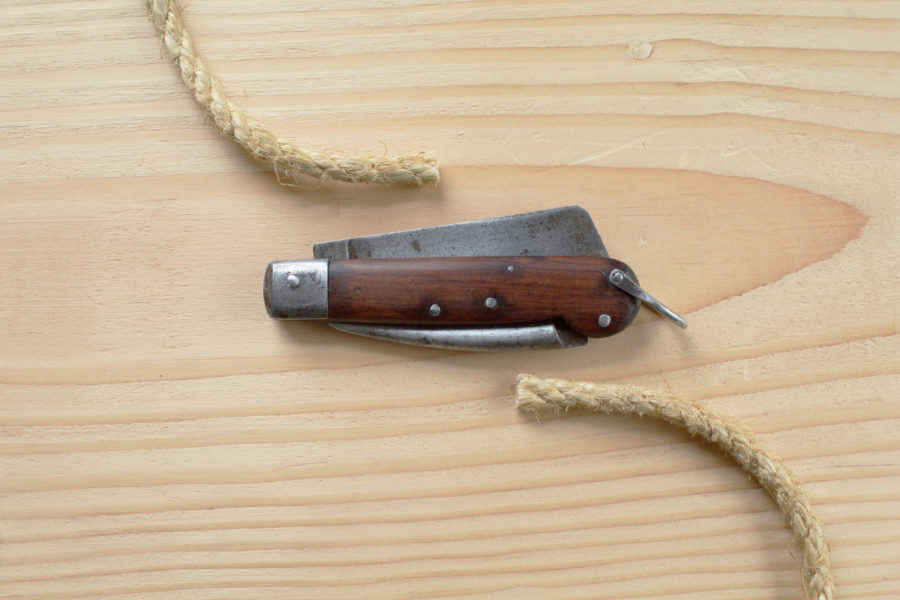
From The Editor
Lost and Found
I have a shelf in the corner of my shop where I pile my collection of tape measures. They frequently fall off the shelf, and this past week I got…
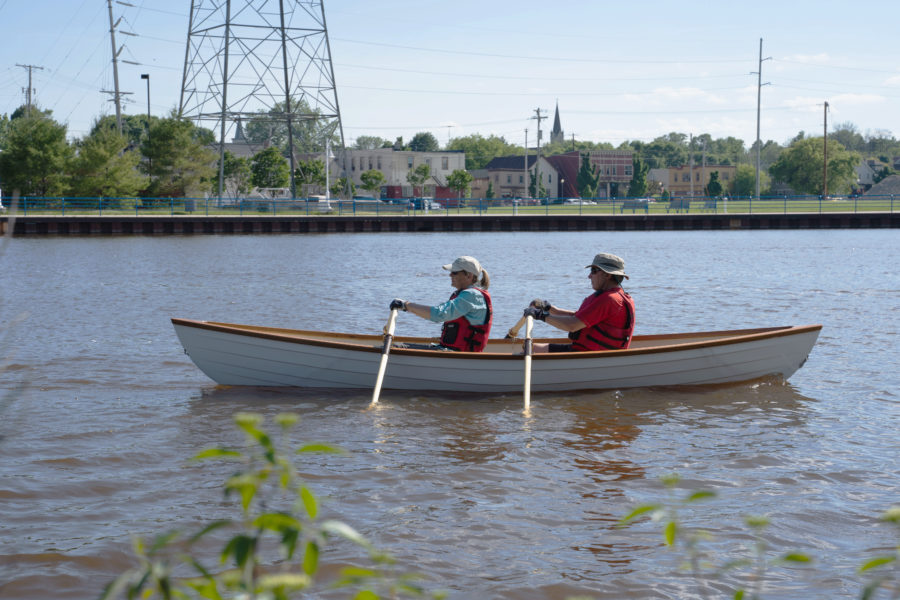
Boat Profile
Crawford’s Gunning Dory
Roger builds his boats one at a time. The Gunning Dory is hand-laid fiberglass starting with rolled-on gelcoat. The layup for the bottom includes biaxial fiberglass cloth, a 1/2″ foam…
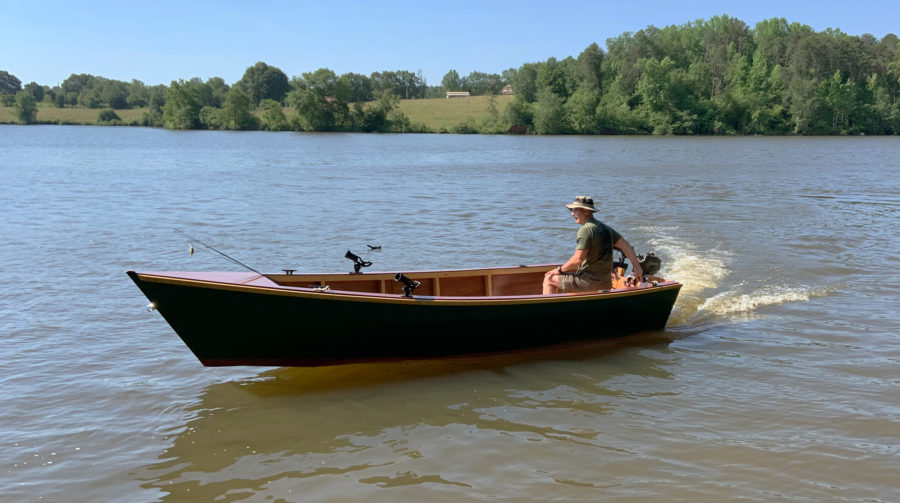
Spira’s Hudson Skiff
I have a full-sized pickup truck, so trailering the lightweight skiff is not at all difficult. Launching at the ramp is similarly not a problem; Hudson floated right off the…
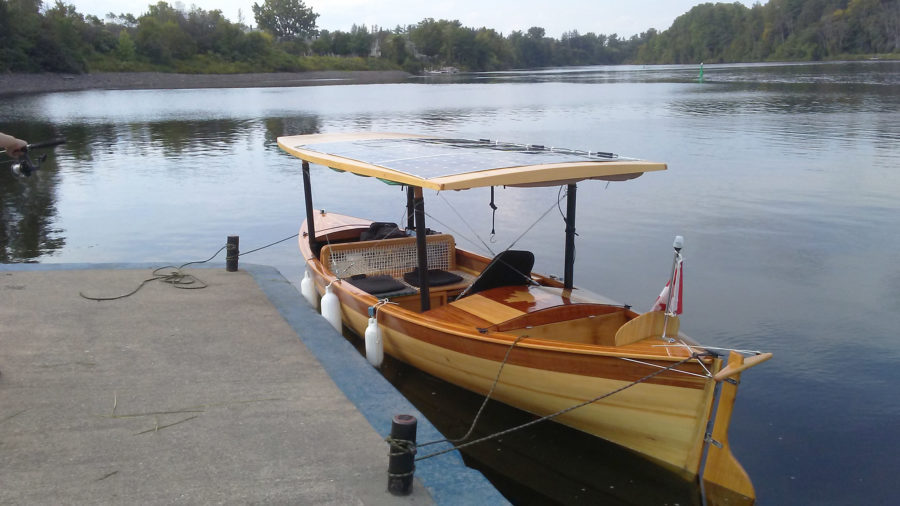
A Solar Solo
SOL CANADA had been performing fairly well, but about once an hour the motor would just stop. I could get it going again by putting the throttle neutral for a…
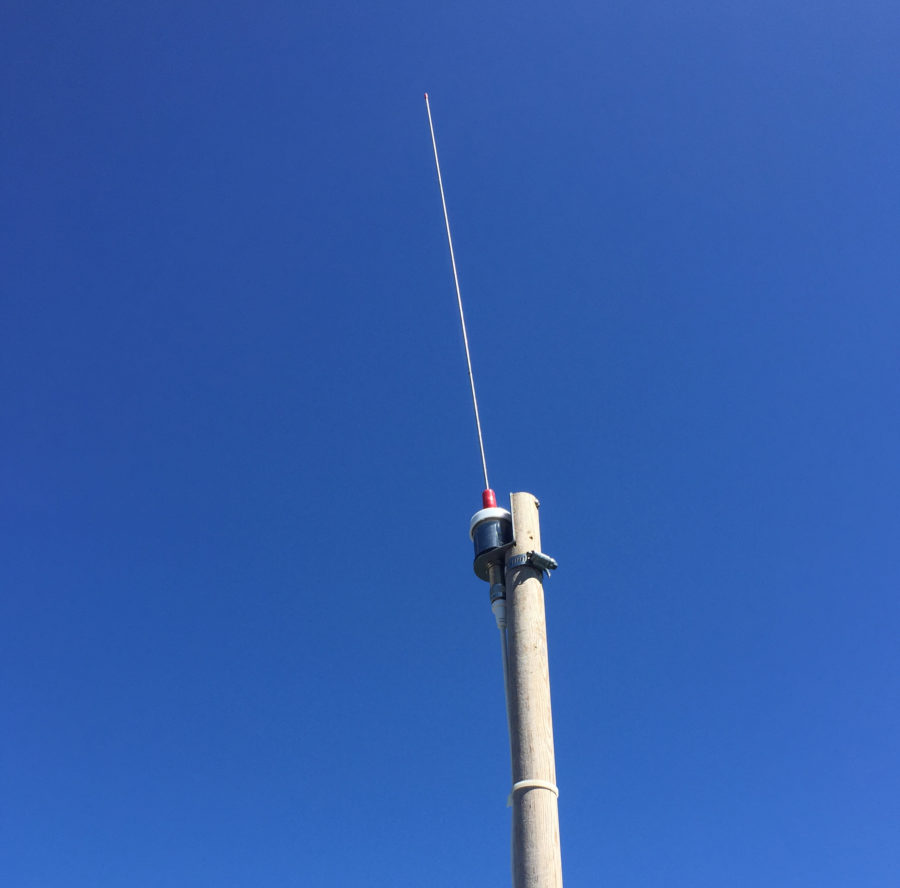
Antennas for VHF
VHF radios, like cell phones, are limited to line of sight. The Coast Guard sets its antennas up as high as possible, often in spots remote from their base, to…
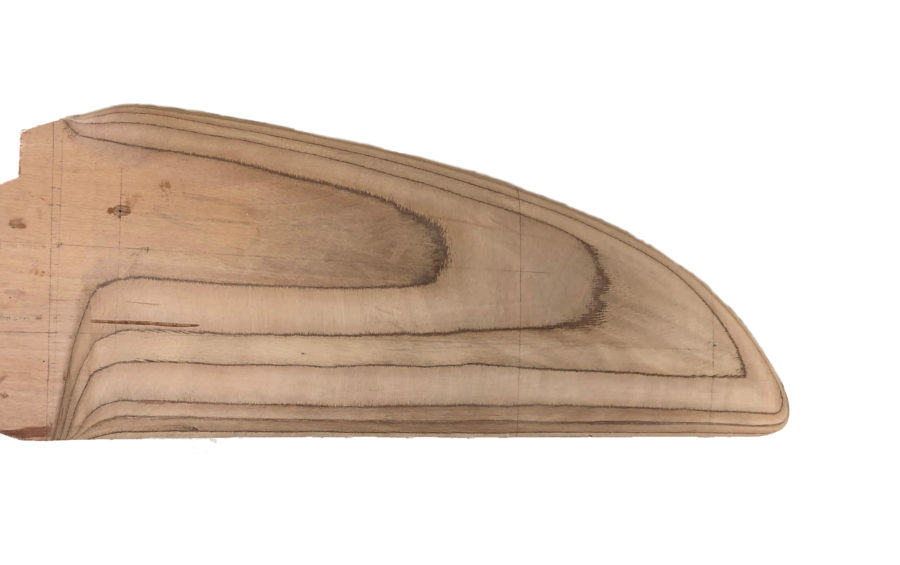
I made a blank for my rudder by gluing layers of marine ply with epoxy to the required 1″ thickness. I have found that the plywood, in spite of its…
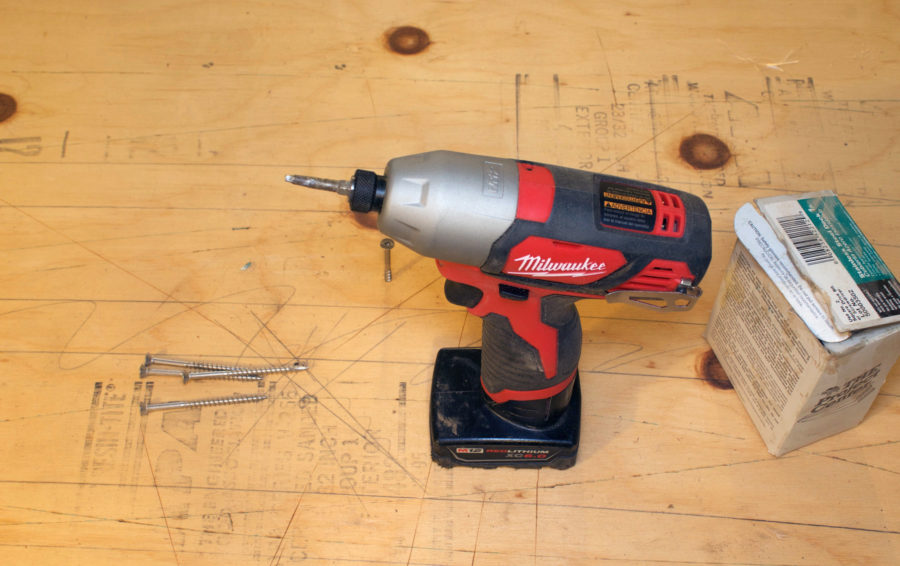
Product Reviews
Impact Drivers
While the impact driver has lots of power, more than enough to shear screws, the variable-speed trigger provides the operator with very good control for the depth of the screw.…
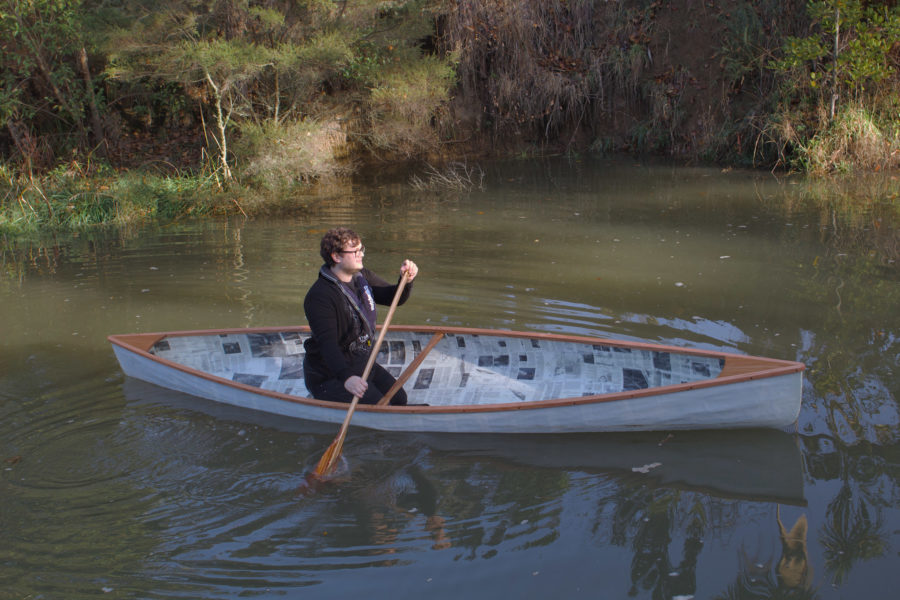
Reader Built Boats
Built by the Book
The lockdown in New Zealand began on March 23 and David stayed home to do his part in slowing the spread of COVID-19. He focused on his canoe projects and…
More Technique
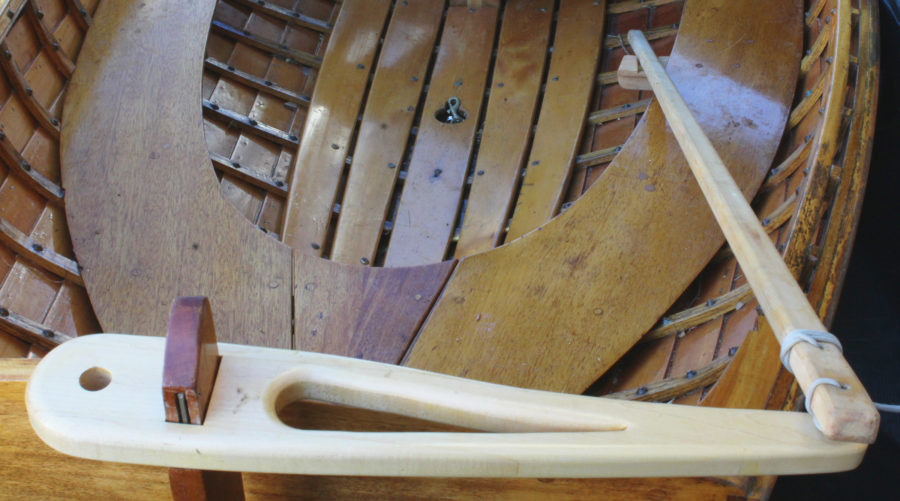
A Norwegian Tiller Keeper
Solo sailors of small open boats have a problem: While we’re sailing we’re stuck minding the helm. Occasionally there’s a need to go forward to adjust the downhaul or centerboard,…
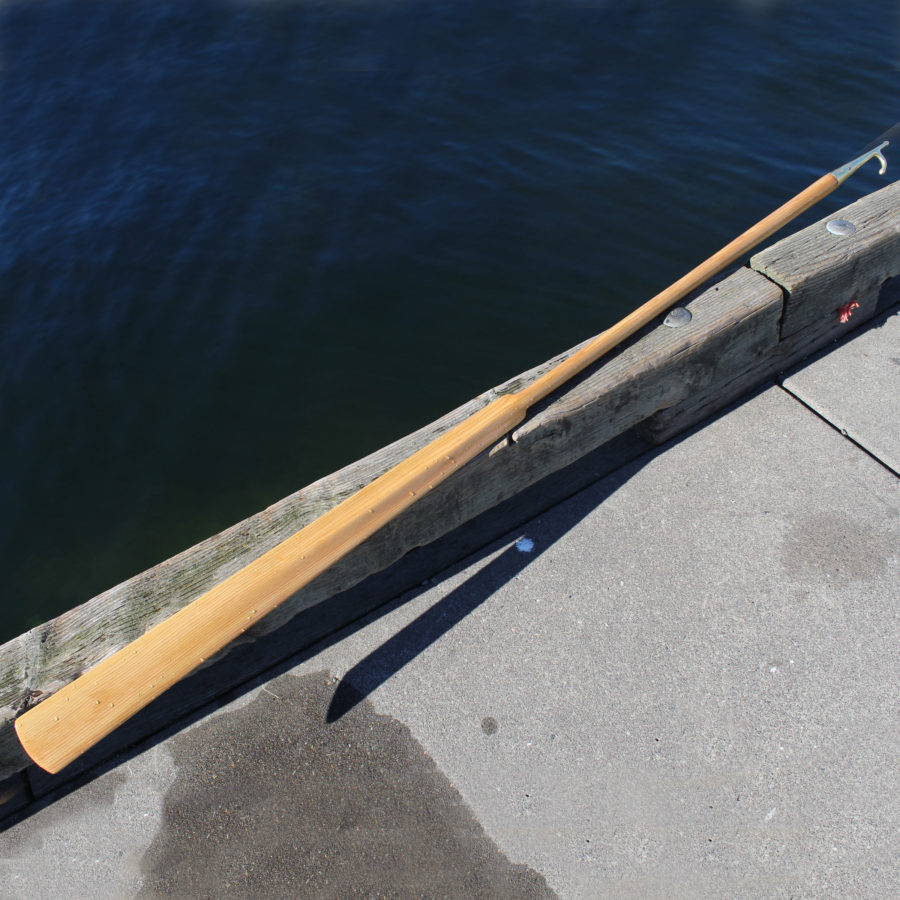
The Skipper and I launch our small sail-and-oar boats from our beach and dock; coming and going we have to negotiate several obstacles. With the boathook we may pole off…
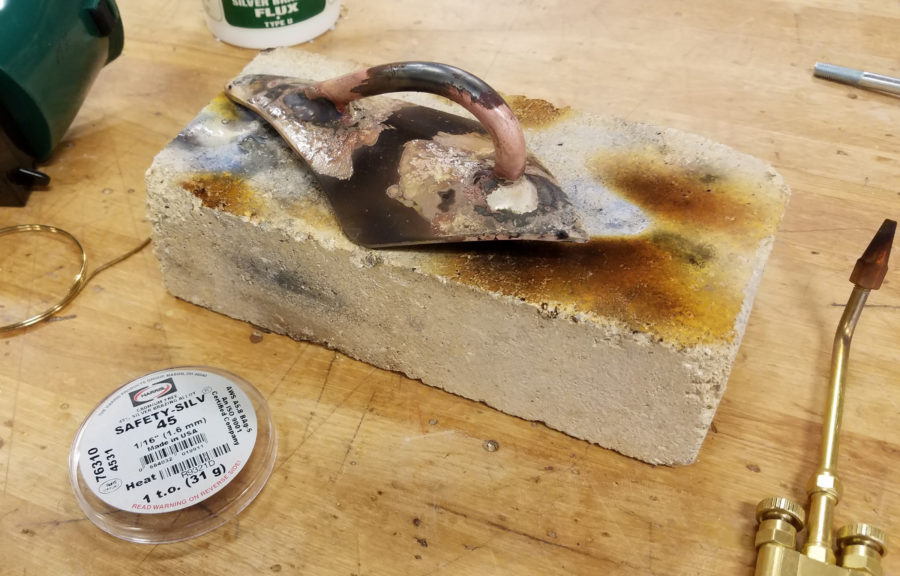
Fillet Brazing for Custom Boat Hardware
By using a brazing alloy that would build up in fillets at the intersections, the resulting radiused transitions would have the appearance of custom-cast fittings. After some experimentation with different…
Subscribe Today!
Become a subscriber today and you’ll recieve a new issue every month plus unlimited access to our full archive of backlogged issues.
Already a subscriber? Sign In
Subscribe For Full Access
Flipbooks are available to paid subscribers only. Subscribe now or log in for access.
Yachting World
- Digital Edition

Monofoil: The pocket rocket that can foil in just 8 knots of breeze
- Matthew Sheahan
- October 1, 2019
Built and developed in secret, the 8m Monofoil is a super-fast one-off foiling monohull, originally designed as a lake racer
The spectacle of a flying catamaran, be it an Olympic Nacra 17, a GC32, the recent America’s Cup 50-footers, or anything in between, has become almost normal in today’s racing world, so rapid has the shift to foiling been among multihulls.
But, even 17 years after they first appeared, the sight of a diminutive foiling Moth still turns heads. Foilers don’t have to be big to be impressive, balancing a single hull on a single foil is enough. Like those who can ride a unicycle, there’s something awe-inspiring about watching sailors who have pitch perfect balance fly a twitchy monohull while making it look like the most natural thing in the world.
There have been plenty of attempts to bring monohull foiling to bigger boats and to the masses. Yet no one has yet cracked the code, at least not for production boats.

Little surprise then, that whenever a new monohull foiler comes onto the scene it attracts plenty of attention. One of the latest is the 8m Swiss-built Monofoil. This extraordinary and complex looking boat is essentially a sportsboat with an open cockpit but with outrigger foils, like bicycle stabilisers, that generate righting moment by pushing upwards on the leeward side.
She was designed by Swiss match racing sailor Eric Monnin and built by Damian Weiss, both of whom shared a common goal: to create a fast foiling monohull for the European lakes.
Interestingly, neither had any desire to create a production version, nor tell the world that this was the answer for others. Instead, they simply wanted to find out if they could fly fast enough on one hull to stand a chance of winning some of the big prizes at Europe’s top lake races, including the famous Bol D’Or Mirabaud.
Article continues below…

Charal: On board the radical IMOCA 60 that takes foiling to the next level
In St Malo for the start of the Route du Rhum in early November, every inch of the IMOCA 60…

Eagle Class 53: The foiling cruiser inspired by the America’s Cup
Not everything that flies is destined to scorch around an America’s Cup course. The future for sailing hydrofoils is surely…
Launched in the spring of 2018 after two years of secret development, the initial signs looked good as the 8m sportsboat delivered an impressive opening performance, topping 25 knots on one of her first outings.
After a winter of tweaking and refining, where the team had increased the foils by 20% and reduced her overall weight by 50kg, the Monofoil was back afloat for this season. Shortly after her re-launch at Easter, it was clear that the team had raised the game.
“We can now foil upwind in just 8 knots of breeze,” said Monnin. “And when the breeze builds to 12 knots we are travelling at 16-20 knots at a true wind angle of around 50-60°. When it comes to downwind performance we can happily sit at 22 knots in 12 knots of wind with the gennaker. After that, when the breeze is up to 15-20 we are holding 24-27 knots with just the main and jib,” he continued.

The carbon bowsprit is 1.2m long and cants so the tack of the gennaker can be set further to windward, allowing the Monofoil to sail deeper
All impressive stuff for an 8m monohull. This is a proper pocket rocket that weighs just 650kg and can be rigged off the road trailer and launched in a couple of hours. Indeed, Monnin explains, her performance was in part limited by the need to keep the maximum beam down to 2.5m to meet European towing regulations.
Single hull foiling
So how does the Monofoil work? Setting the foils to one side to start with, the 8m long sportsboat flies a self-tacking jib upwind and a gennaker off a canting bowsprit downwind. She is designed to be raced by a full crew of four, including the helmsman, with two on trapezes to boost the righting moment.
She has a large square-topped mainsail that makes full use of the available space in a sail plan that sees the boom extend all the way to the transom where a full width traveller allows plenty of mainsheet tension to keep the head of the main stand up. This does mean she has a pair of running backstays rather than a single fixed stay, but double aft swept spreaders provide sufficient fore and aft support for the mast.

The foil deployed, but in the raised position. Normally it wouldn’t be underwater but the boat was heeled at the dock
Being a potent performer, she sails at high apparent wind speeds with the apparent wind ahead of the beam. This makes the full width mainsheet traveller an important feature to allow the mainsail to be dropped down to leeward while still maintaining leech tension, much like a multihull.
Her rudder is mounted on a transom-hung gantry to ensure greater efficiency for the T-foil blade. The rake of the rudder can be adjusted to alter the fore and aft trim of the boat.
While the foils look large and complex, their operation is surprisingly simple and belie the amount of work that has gone into designing a complete system that allows the curved foils to slide through a set of bearings in the hull.

A simple rope-driven worm drive alters the rake of the T-foil rudder, which in turn alters the trim of the boat. The rudder is mounted on a gantry off the transom to minimise cavitation
Much like the Beneteau Figaro 3, the idea is that both boards are lowered when sailing. Yet unlike the Figaro, the windward board is lifted partially to help raise it above the water’s surface and reduce the chances of it becoming immersed where it would create drag.
The clever part is the small amount of movement that is required to lift and lower the boards, especially when compared to the amount of movement required to raise and lower daggerboards on a modern multihull.
Also unlike the Figaro, the Monofoil’s boards are fully retracted in light winds. With very little of the foil in the water there is minimal drag and the boat can be sailed like any other monohull.

A custom bearing lets the daggerboard slide vertically to be raised or lowered. Rake is adjusted by the green line winding a worm drive
In these conditions the skinny and efficient 2.2m deep keel, with its 160kg bulb, is a good combination when the breeze is below 8 knots and allows the Monofoil to perform like any other similarly sized sportsboat.
The dihedral (upwards angle) of the foils is also an interesting feature that provides a degree of automatic heel control. As the boat accelerates and comes upright, so less of the foil is in the water, which reduces vertical lift.
Deceptively simple
At rest this boat does look pretty complex, yet once she’s rigged and underway you realise how simple she is to operate as well as how much effort has gone into designing her that way.

Below decks the full carbon construction is clear to see
This is an ingenious trailer-sailer that will fly in light conditions and be stable on foils right up through the wind range, something the crew demonstrated during this year’s Mirabaud Bol d’Or. As a vicious 50-plus knot storm swept through the fleet, she and her crew were one of the few to survive unscathed and go on to complete the overnight race.
The irony remains that – unlike many others in the Bol d’Or – this is not a boat that was intended to be the prototype for a new range of production foilers, even though she appears to provide answers to plenty of questions.
The bottom line is that the Monofoil seems to work. Irrespective of what speeds she clocks up, what is most impressive is how she performs across such a wide range of wind speeds.

Rectangular cut-outs in the hull allow the foil to be lowered completely on the leeward side. The windward foil is raised slightly in a similar way to pulling up a normal daggerboard
The Monofoil is no one-trick pony and while the concept wasn’t created for production, it could provide an appealing route for those who are realistic about their ability to learn how to balance like a Moth sailor, or ride a unicycle.
Specification
LOA: 8.0m (26ft 3in) Beam: 2.5m (8ft 2in) Displacement (empty): 850kg (1,874lb) Mast height: 12.2m (40ft 0in) Mainsail area: 32m 2 (345ft 2 ) Headsail area: 16m 2 (172ft 2 ) Gennaker area: 50m 2 (538ft 2 )
Moomba Boats unveils the best rough boat of 2025 with revolutionary features
New York, United States - September 10, 2024 —
Moomba introduces its 2025 lineup, featuring the best rough boat for wake surfing, wakeboarding, and more, with advanced technology and unbeatable performance
Moomba Boats, known for producing high-performance boats for watersports enthusiasts, has officially launched its 2025 lineup. This release showcases the best rough boat 2025 has to offer, combining innovative technology, enhanced power, and modern design to dominate challenging waters. Moomba’s latest collection reinforces its position as a leader in the wake sports industry, delivering an uncompromised boating experience that caters to both seasoned athletes and recreational users.
The best rough boat 2025 lineup by Moomba is designed to deliver consistent performance, even in the most challenging conditions. Built to handle rough water with ease, these boats are equipped with powerful engines, innovative control systems, and customizable wake technology, providing an unparalleled experience for those who enjoy wake-surfing, wakeboarding, or cruising in less-than-ideal conditions. The Moomba 2025 lineup has been engineered to meet the growing demand for high-performance boats that can handle rough water while providing the quality and reliability Moomba is known for. The collection is designed to outperform in every aspect, combining power, technology, and comfort, making it the top choice for boaters seeking the best rough boat 2025 can offer.
Moomba’s commitment to providing the best rough boat in 2025 starts with its innovative Flow 2.0 Surf System, which comes standard across the entire 2025 lineup. This advanced surf system has been engineered to create large, customizable wakes, ensuring the optimal experience for riders of all skill levels, even in rough water conditions. Along with the Flow 2.0 Surf System, Moomba’s patented AutoWake technology is included to ensure precise wave formation, regardless of water conditions or boat load. AutoWake continuously monitors the boat’s position and automatically adjusts the wake to suit the rider’s needs, making it the perfect addition to the best rough boat 2025 collection.
The combination of the Flow 2.0 Surf System and AutoWake technology in the Moomba lineup guarantees that even in rough water, riders can enjoy smooth, well-formed waves that are perfect for wake-surfing and wakeboarding. Whether you’re navigating choppy conditions or glassy water, these systems ensure optimal performance every time. Powering the best rough boat 2025 lineup is the Moomba Raptor Series by Indmar. These powerful engines are engineered for maximum torque, fuel efficiency, and durability, making them ideal for handling rough water and towing multiple riders.
Available in three configurations—the 6.2L, 5.7L, and 6.2L HO—the Raptor engines ensure that the best rough boat 2025 offers the power and reliability needed for wake sports. With ample horsepower and torque, these boats deliver smooth performance even in less-than-ideal conditions, making them ideal for families, recreational boaters, and professionals alike. The Raptor engines also offer superior fuel efficiency, ensuring that boaters can enjoy longer days on the water without worrying about excessive fuel consumption. This combination of power and efficiency makes the Moomba lineup the best rough boat 2025 for anyone looking to maximize their time on the water while navigating through challenging conditions.
The Moomba 2025 lineup brings together rugged performance with luxurious comfort, making it the best rough boat 2025 in terms of both style and function. The interiors of these boats are reimagined to offer spacious seating, superior comfort, and user-friendly layouts that make them perfect for long days on the water, regardless of the conditions. Moomba’s GatorStep non-skid flooring is now available in multiple colors, allowing customers to personalize their boats to their tastes. The high-quality, durable flooring ensures safety and comfort, even in rough water. The transom walk-through design also enhances convenience by providing easy access to the swim platform, making it easy to move around the boat when conditions get choppy.
With sleek, modern aesthetics, Moomba's best rough boat 2025 lineup seamlessly combines form and function. The stylish design is paired with the rugged construction necessary to tackle tough water, offering an unbeatable combination for boaters looking for high performance and head-turning style. The 2025 Moomba lineup also delivers an upgraded entertainment experience, ensuring that the best rough boat 2025 isn’t just about performance but also about enjoying the ride.
The enhanced audio systems feature premium speakers and state-of-the-art audio technology, providing crystal-clear sound no matter the conditions. Whether you’re cruising through rough water or enjoying a quiet day on the lake, the audio systems in Moomba boats provide an unmatched listening experience. Additionally, the advanced helm interface gives boaters complete control over their experience. With an intuitive display system and enhanced touch controls, drivers can easily manage boat functions while staying focused on the water.
These connectivity features ensure that the best rough boat 2025 provides not only top-notch performance but also seamless operation and entertainment options. The best rough boat 2025 lineup includes a range of models that are designed to meet the specific needs of different watersport enthusiasts. Whether it’s wake-surfing, wakeboarding, or simply cruising through rough water, Moomba is a model for every kind of adventure.
Moomba Kaiyen: This versatile 21’5” model offers a perfect balance of performance and comfort. Equipped with the Flow 2.0 Surf System and GatorStep flooring, the Kaiyen is designed for maximum fun and performance, even in rough water. Moomba Craz: The Craz delivers the ultimate wakeboarding experience, with a powerful engine and ample ballast capacity to create the perfect wake in any condition. Its durable design makes it one of the best rough boat 2025 models for wakeboarding enthusiasts.
Moomba Makai: At 24.5 feet, the Makai is the largest in the lineup and offers a spacious interior, making it ideal for families and larger groups. The Makai’s advanced wake system and robust construction make it the best rough boat in 2025 for those seeking both luxury and performance. Moomba continues to set itself apart by offering the best rough boat 2025 models without compromising on affordability. Designed with both quality and value in mind, the Moomba lineup provides premium features and performance at a price point that makes it accessible to a wider range of customers. Each boat in the 2025 lineup is engineered to handle the challenges of rough water while offering the technology and comfort that Moomba is known for. The combination of affordability, quality, and performance makes the best rough boat 2025 models a standout choice for boaters seeking a top-tier experience without the high-end price tag.
About Moomba Boats
For over two decades, Moomba Boats has been a leading name in the watersports industry, delivering premium wake-surfing and wakeboarding experiences. Known for their commitment to innovation, performance, and affordability, Moomba continues to push the boundaries of what’s possible on the water. The 2025 lineup of best rough boats reaffirms the brand’s dedication to creating high-quality, accessible boats for enthusiasts of all levels.
For more information on Moomba Boats and the best rough boat 2025 models, visit moomba.com .
Contact Info: Name: Adam Higson Email: Send Email Organization: Moomba Boats Phone: +18659839924 Website: https://www.moomba.com/
Release ID: 89140749
In the event of encountering any errors, concerns, or inconsistencies within the content shared in this press release, we kindly request that you immediately contact us at [email protected] (it is important to note that this email is the authorized channel for such matters, sending multiple emails to multiple addresses does not necessarily help expedite your request). Our dedicated team will be readily accessible to address your feedback within 8 hours and take appropriate measures to rectify any identified issues or facilitate press release takedowns. Ensuring accuracy and reliability are central to our commitment.

IMAGES
VIDEO
COMMENTS
The class has a specially built oven and foil molds for those who want to build their own. And anyone interested is encouraged to employ the expertise and skills of their fellow sailors. ... Electric 'Flying' Foiling Day Boats: The Best of 2024. Emma Coady. February 1, 2024. Foiling Catamarans. Zuzana Prochazka. January 31, 2019. Boat Reviews.
Enata Foiler. Dubai-based Enata Marine added a healthy dose of glamour to the world of foiling boats in 2018 with the launch of its Foiler. In addition to a superyacht tender-worthy exterior, this 32fter includes a bow window for spectacular views while underway. A 40-knot top speed and a 190nm range makes this a very appealing option, although ...
Produced by the Dutch company Aeronamics, it has a soft, almost C-shaped foil. There is no adjustment of the rake of the appendages but only its extension in the water, which makes the "trim" of these appendages easy and intuitive after just a few trips. Top speeds are around 20 knots. Price: 15,495 euros.
Baltic 111 Raven is a 34-meter-long, foil-equipped sailing superyacht. It is a high-performance yet comfortable boat designed for short high-speed cruises. The project was designed by Botin Partners and PURE Design, two names at the forefront of yacht building including America's Cup yachts.
At A Glance. Price As Sailed: $24,750. Design Purpose: Learn to foil, advance skills. Crew List: One or two. Rob Andrews and his business partner Alan Hillman have been teaching foiling for a ...
Jul 22, 2024. Original: Nov 30, 2018. With the TF10, big-boat multihull foiling is now available to amateurs as well as pros. Any time I put a helmet on I become hyper-aware of every step I take. Precaution means there's an alternative to a happy ending. On one of my last rides of the 2018 summer season, the helmet was mandatory, as was the ...
Candela, a new 25-foot production e-foiling powerboat (and 2019 Best of Boats award winner) offers such a solution with foils that change position 100 times per second! Still, at ~$240,000 it's well beyond most boating budgets. Fortunately, smaller foilers (dinghies and boards) don't require high tech flight control systems and are far less ...
Hydrofoil sailboats blend speed, stability, and innovation for a fun sailing experience. Their design lifts the hull above water, reducing drag and enabling high-speed travel. Advanced control mechanisms maintain stability in varying wind conditions. Sails and hulls are meticulously engineered for optimal aerodynamics and lift.
Technical details. The F1x A-class foiling catamaran has a number of unique features that improve performance. For example: Semi ridged trampoline. Gives extra torsional stiffness to the boat and increases its aerodynamic characteristics. Patented main-sheet-wheel-system. For more direct and faster trim of the main sail.
A foil catamaran, also known as a hydrofoil catamaran, works by utilizing hydrofoils to lift the hulls out of the water. These foils generate lift as the boat gains speed, reducing drag and allowing for faster and smoother sailing. The lift created by the foils enables the catamaran to "fly" above the water, resulting in increased speed and ...
The TF10 is an 11 m long one-design foiling trimaran, designed by the famous yacht designers Morrelli & Melvin. The TF10 is built and sold by DNA Performance Sailing. The TF10 is suitable for a crew of 4-5 persons and can handle a wide range of sailing conditions. The construction consists of pre-preg carbon fibers with a Nomex honeycomb core.
The best evidence that foiling monohulls truly are here to stay came just a month after the Vendée Globe start when Beneteau introduced its new Figaro 3 design, drawn by VPLP, at the Salon Nautique de Paris in December. This represented a huge commitment by one of the world's biggest boatbuilders.
A boat that would only float the right way up if you were moving and required the balance of a cat on a fence from the helmsman was a challenge too far for many sailors. ... The main foil and ...
The flight control system, combined with numerous fine-tuned innovations, ensures safe foiling even in strong winds and rough seas.. Stable flight attitude allows pushing hard, so in good conditions, iFLY reaches high boat speed beyond 30 knots in a controllable way. IFLY15 offers freedom to fly alone or in pairs.
The L-foil is exactly that; a vertical daggerboard shaft that goes through the hull of the boat, with a single horizontal hydrofoil on the bottom, the whole thing shaped like an 'L'.
Italian Enrico Forlanini began experimenting with foils in 1898. In 1906, his 1-ton 60 hp foiler reached 42.5 mph. Alexander Graham Bell's HD-4 Hydrodrome flew on Bras d' Or Lake at 70 mph in 1919. And several sailing foiler patents began appearing in the 1950s. Notably, JG Baker's 26-foot monohull, Monitor, flew at 30-plus mph in 1955.
With razor-sharp hydrofoil catamarans that help them hit speeds of 60 miles an hour, the athletes of SailGP are pushing the limits of physics and human endur...
The Foil Cat holds 400 gallons of fuel and with twin Mercury 400 Verado engines, has a 600-700-mile range, cruising at an easy 32 mph. That horsepower and speed provides an economical 2 mpg burn. The amidship location of the 28" foils come into play as the boat planes, balancing the amount of boat in the water, both foils and propulsion units ...
Then friction only acts on the small foils, not on the whole hull, which is why a 130-foot hydrofoiling sailboat can "fly" at over 50 knots. Powerboats have added friction from the propulsion system that has to remain in the water, but even then, large hydrofoiling ferries can exceed 45 knots. Speed is not the only advantage that hydrofoils ...
To understand the evolution of foil sailboats we interviewed Max Sirena, Giovanni Soldini and Giancarlo Pedote.
We can recommend the best iFLY setup and accessories for your boat. A great number of innovations all over the catamaran and the perfect match of all components allow controlled high-speed foiling experience. iFLY15 is full of innovations, e.g. in hull design, hydrofoils, rudders, automatic flight control system, two-layer wing trampoline, high ...
Other sources suggest that the NACA (National Advisory Committee on Aeronautics) symmetric foil sections, originally developed during aircraft research, are actually a good fit for boat foils operating at low speeds in water. A NACA 0010 foil, for example, has a maximum thickness of 10 percent of the width of the foil, located at 30 percent ...
Shortly after her re-launch at Easter, it was clear that the team had raised the game. "We can now foil upwind in just 8 knots of breeze," said Monnin. "And when the breeze builds to 12 ...
Weve expanded our aluminum fishing boats lineup with the Lund 2075 Impact XS. If your looking for the perfect family fishing boat this boat is built for serious anglers with a center rod locker massive storage including dedicated tackle tray storage large casting decks and even rear jump seats and a ski pylon option.
New York, United States - September 10, 2024 — . Moomba introduces its 2025 lineup, featuring the best rough boat for wake surfing, wakeboarding, and more, with advanced technology and ...